SE Asia — Pictures I: Chronologically
Okay, I always keep my promises eventually, so now I’ll put up my pictures from my southeast Asia adventure. Here’s how I’m going to do this: I’ll make two posts. This one will be full of pictures that show you all the places I went to. The second post is one that Micah put me up to—he told me before I left to keep my eye out for awesome patterns, and if possible to send some back for him. Little did I know before leaving that I was going to a land where covering a building with awesome patterns is considered the best way to decorate it, and all buildings are given this treatment. So, this post will mainly be pictures of whole buildings and places and such, and the second will be full of details.
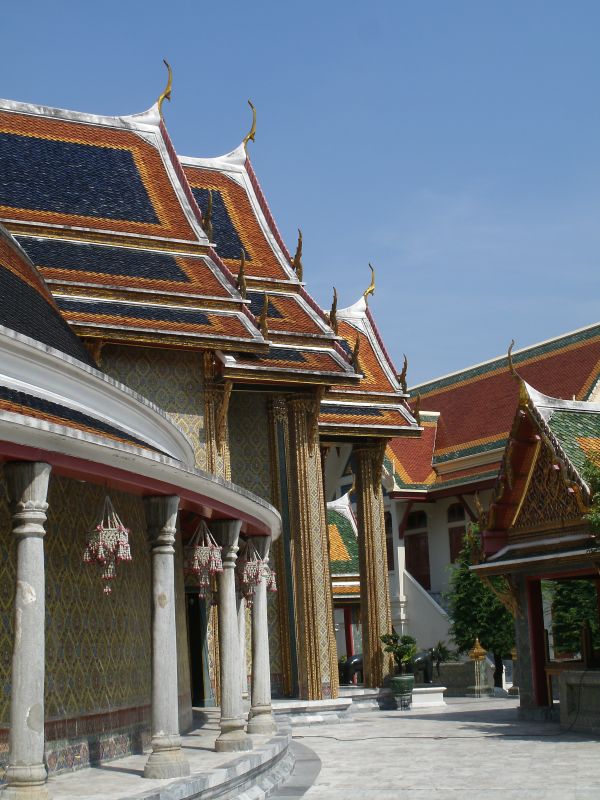
This picture and the next few are from the Rajbophit temple complex in Bangkok. It’s the first big monument I found after landing in southeast Asia. And it was practically empty, which I never figured out. The nearest I could guess was from a plaque telling the complex’s story; it’s supposed to be a fusion of ancient temple-building styles and modern French-influenced architecture. So maybe it doesn’t have enough history, or maybe no one likes the colonialism built into it.
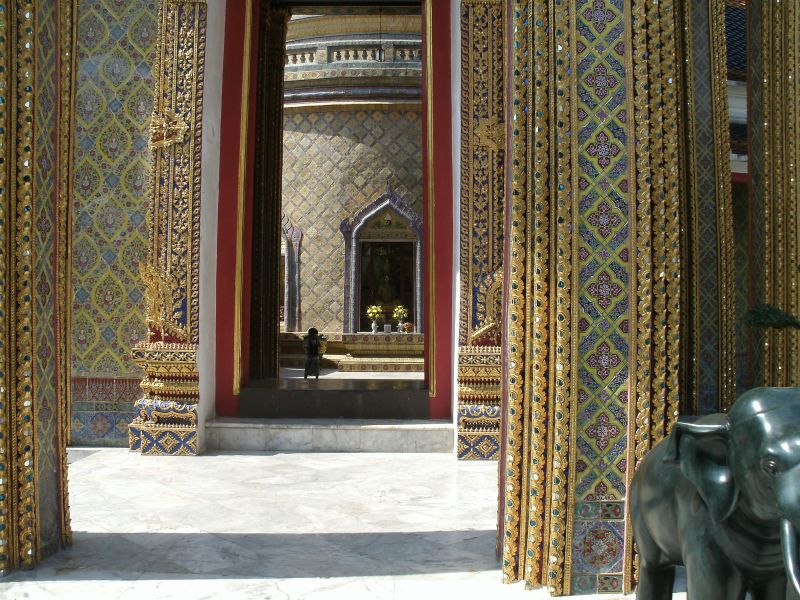
But in any case it wasn’t totally empty—the occasional kid was wandering around in it.
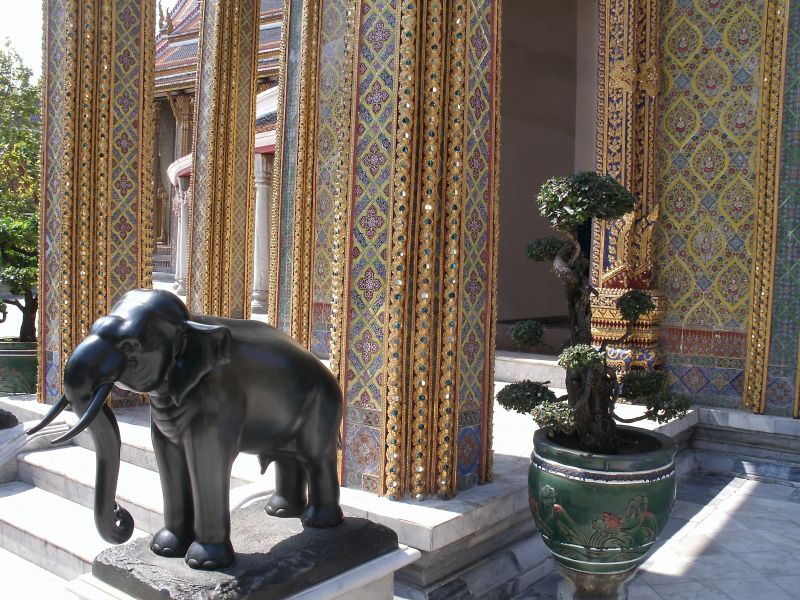
Everything was made with the utmost care. Consider how much effort must’ve gone into creating those walls. Painting the patterns, sculpting the molding, inlaying the colored glass. And then there’s making an elephant, and growing a bonsai.
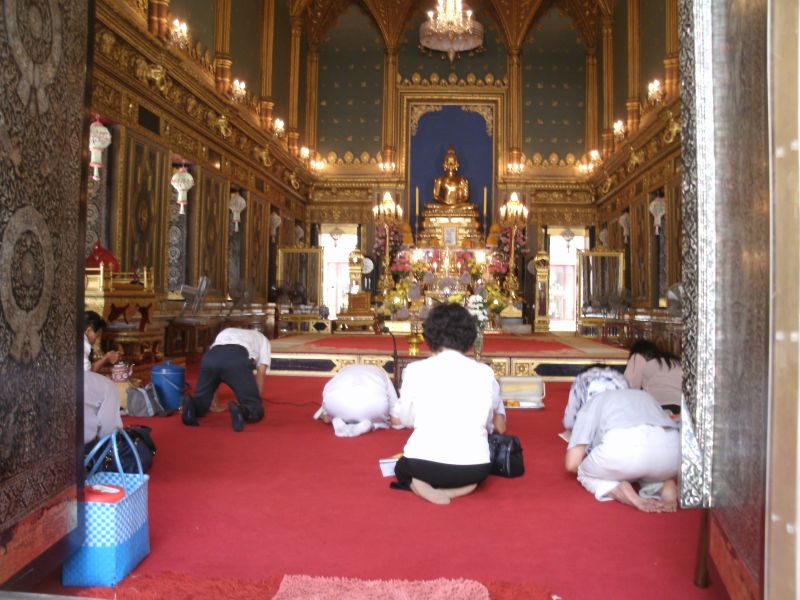
One of the few places I found people in Rajbophit was in an actual temple with a Buddha in it. Almost every temple I found in southeast Asia—modern or ancient, whole or nearly rubble—had an assortment of people doing this: sitting, bowing low, leaving money, and often burning incense.
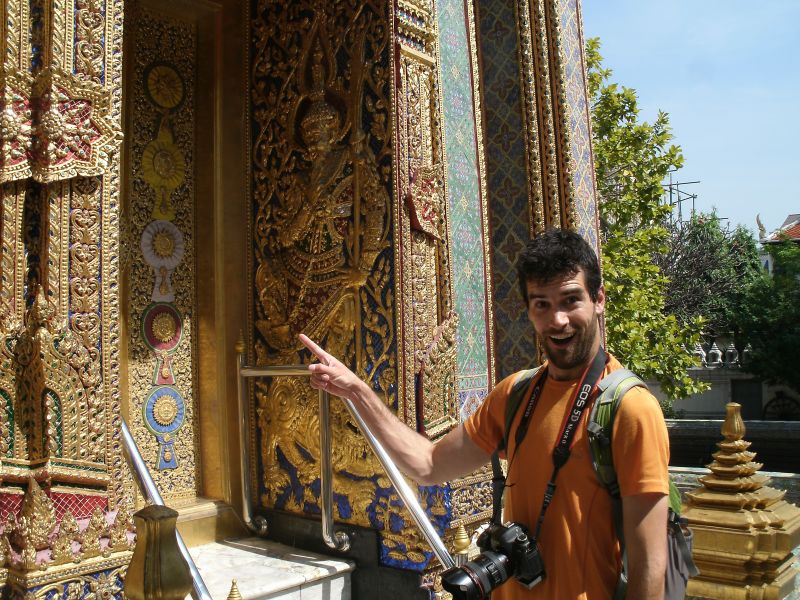
The only other tourist I met in Rajbophit was Glenn from Colorado. We talked about how puzzling the emptiness was here, and he told me about his trip to Nepal. In this photo he does a good impression of someone totally lame.
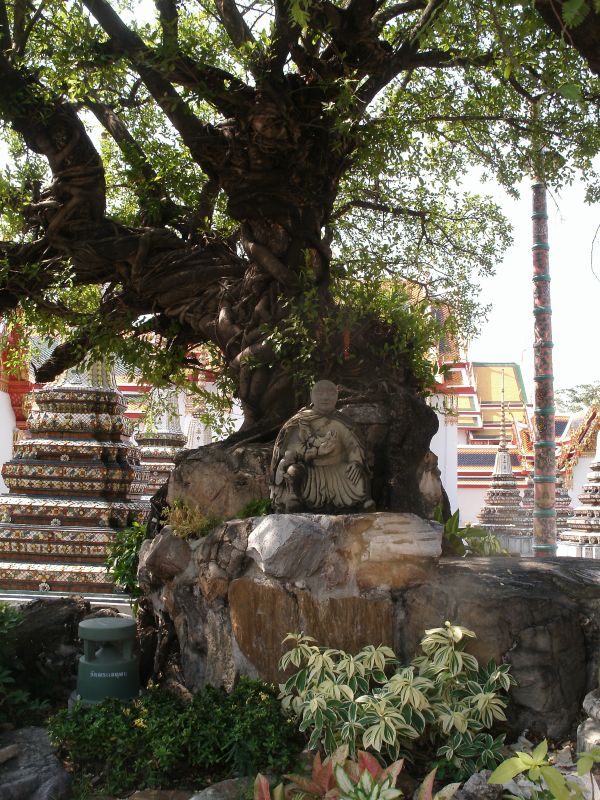
Together we moved on to Wat Pho. It was a collection of lots and lots of temples, monuments, and statues of various sorts. For example, here’s the Buddha sitting on some rocks under an amazing tree.
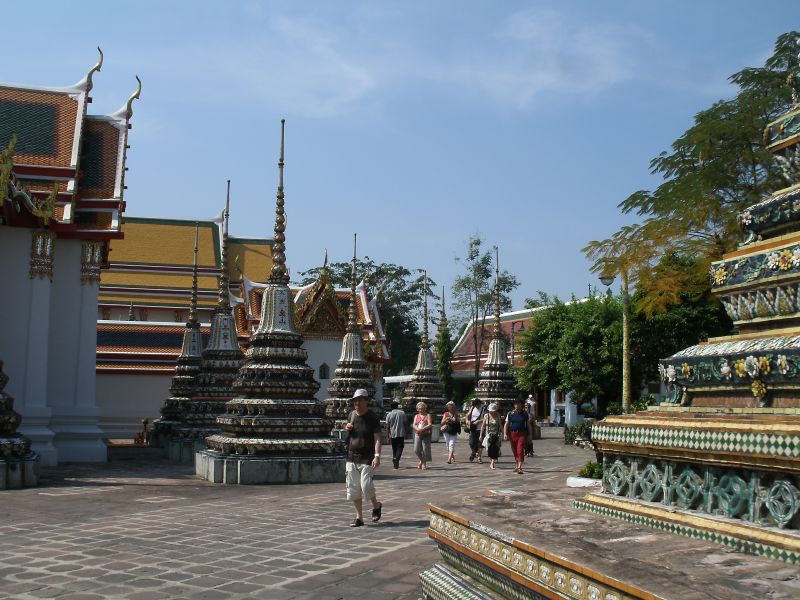
These are stupas. Wat Pho has dozens of them. Again, consider the details.
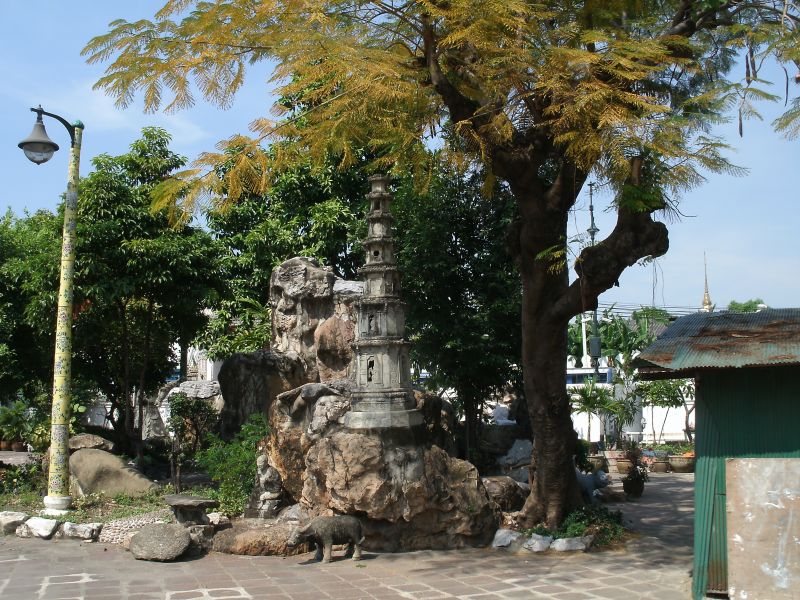
A pagoda.
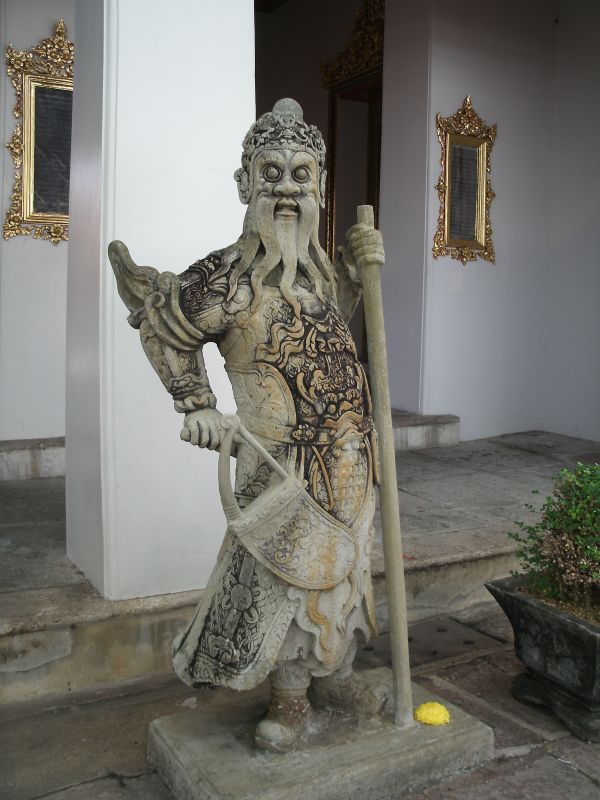
This plucky fellow was guarding the way to the next courtyard.
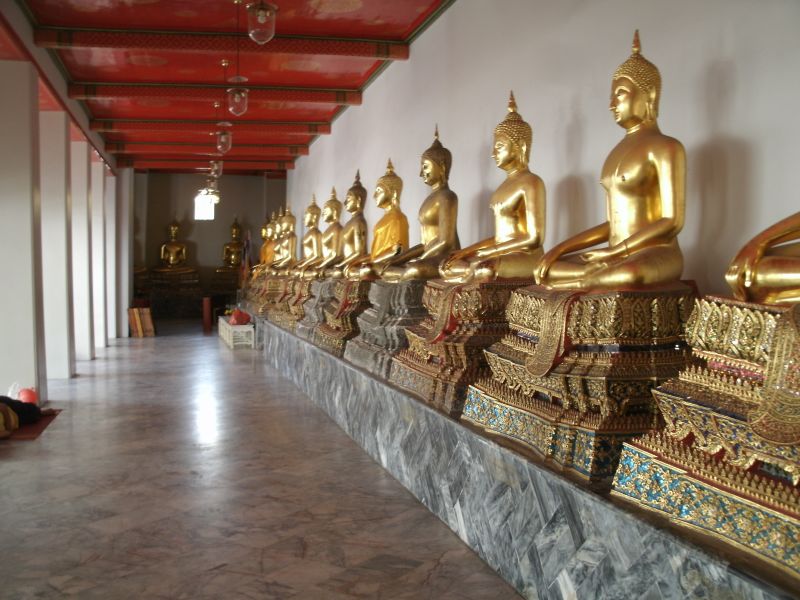
The walls of the courtyard were lined with dozens upon dozens of these Buddhas, each one representing a long time of intense craftsmanly devotion.
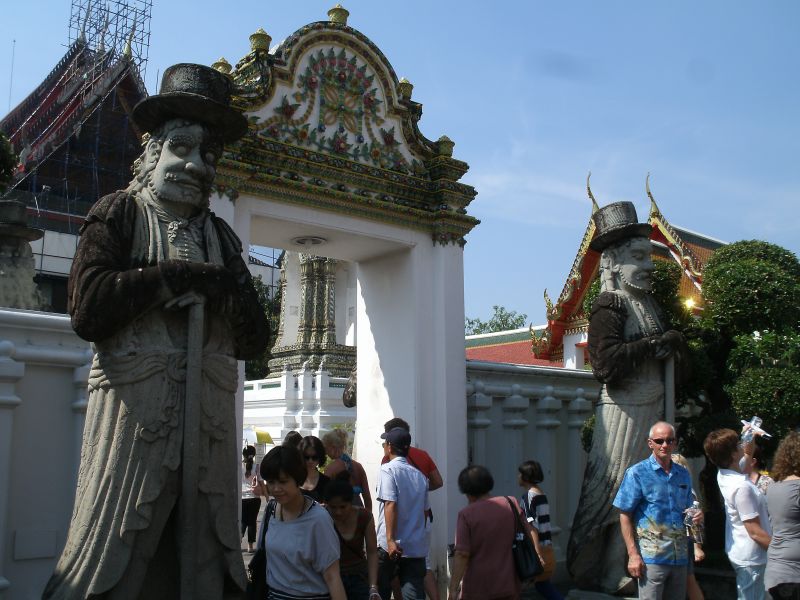
More guards, these ones with awesome hats. I believe Micah has some similar hats.
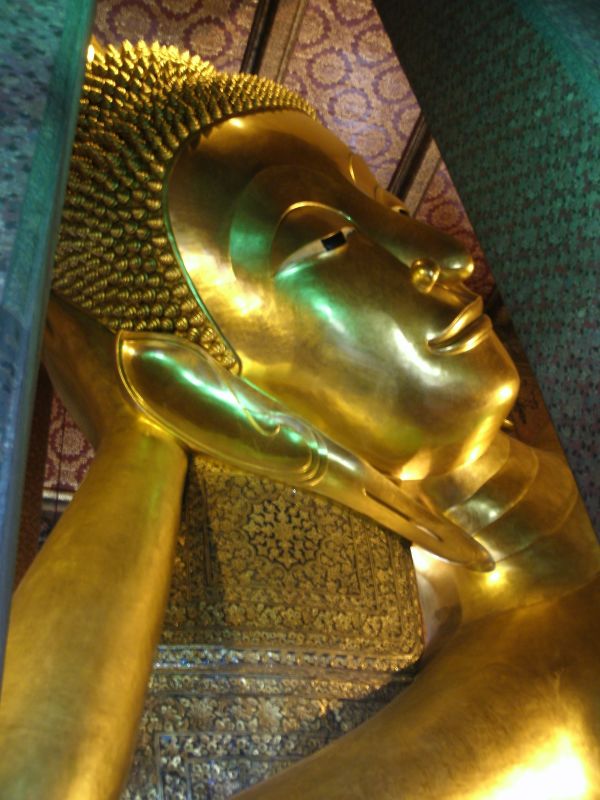
Inside an elaborately decorated purpose-built building lies the largest Reclining Buddha statue in the country. This is one of a few permissible poses for depicting the Buddha. It represents him at the moment he passed into final nirvana.
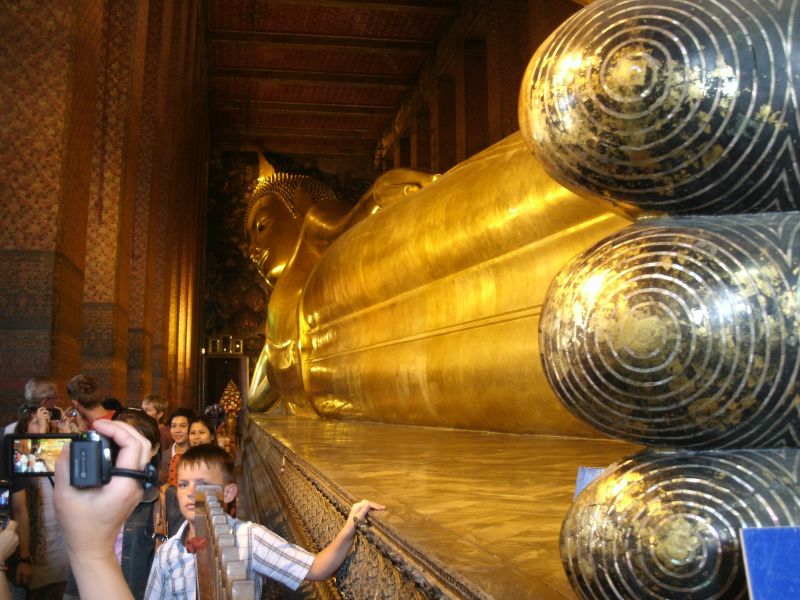
We’re talking about a big Buddha.
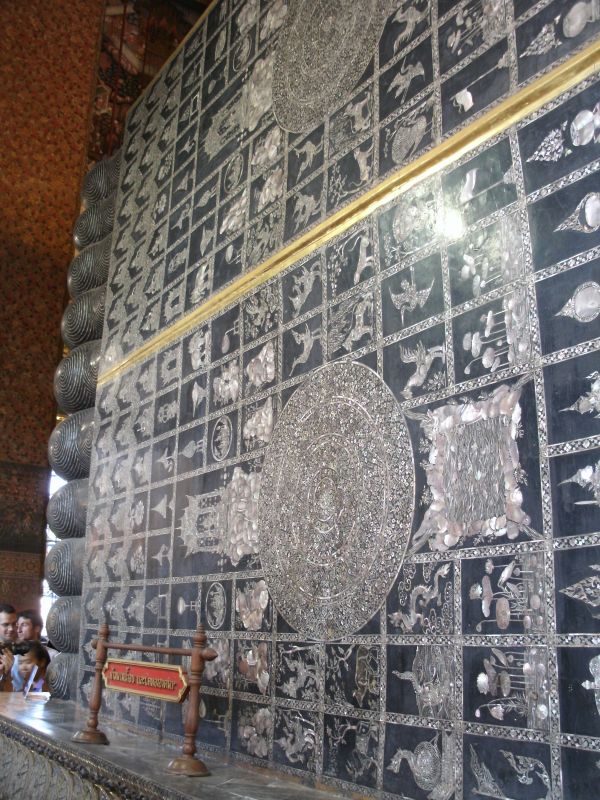
Feet are looked down upon all throughout the region as the cesspool of the body. But the Buddha is so holy that even his feet are worthy of high respect. The kind of respect that involves inlaying hundreds of intricately detailed auspicious symbols into them.
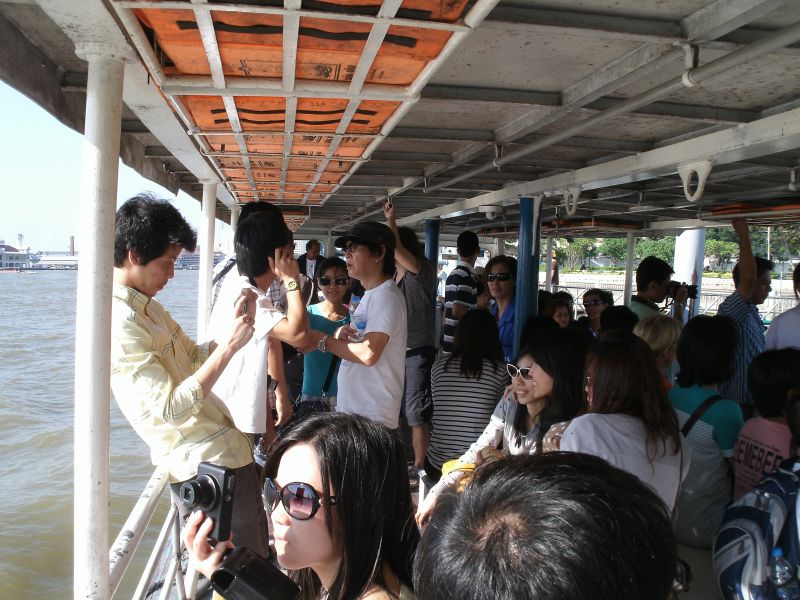
Later, Glenn and I stuck together and got on a boat across the Chao Phraya to see another wat. Every public transportation vehicle the whole region through is packed tight on pretty much every trip. But hey, the trip cost three baht—a dime.
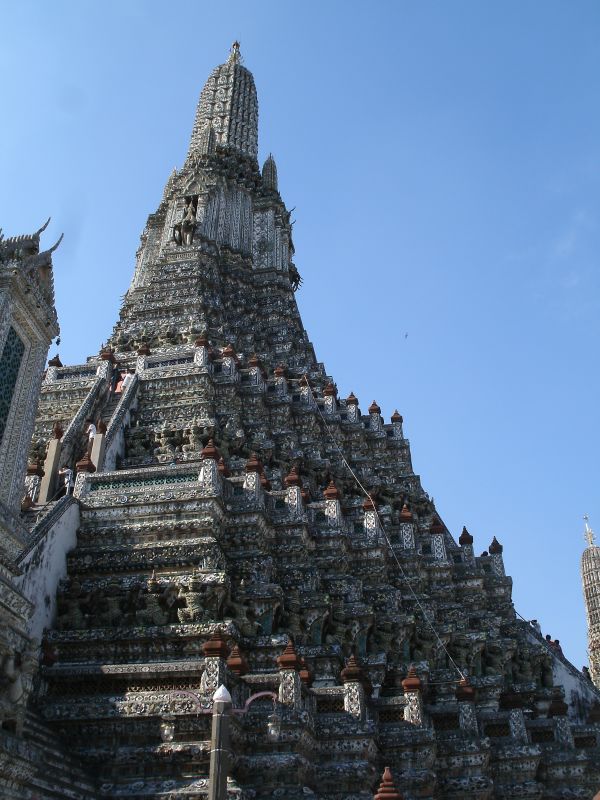
Here’s what we came for: Wat Arun, the Temple of Dawn.
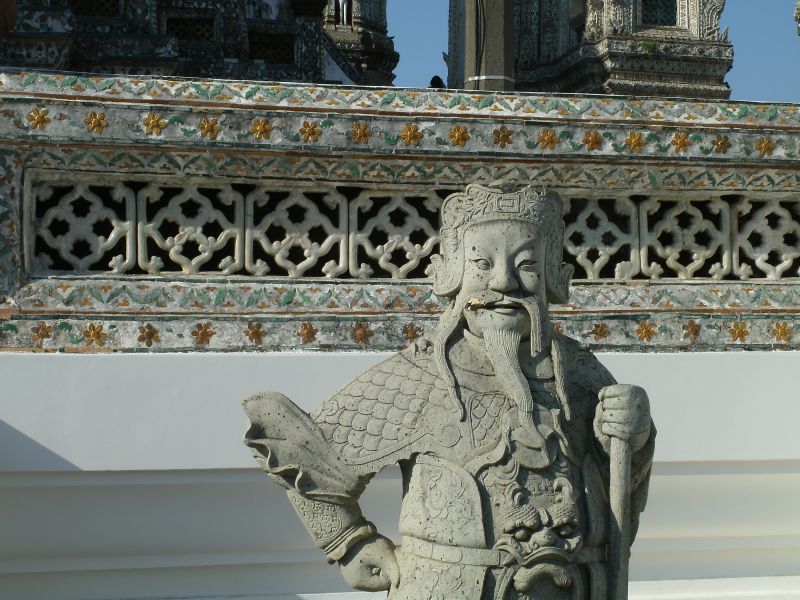
It’s nice to have someone looking out.
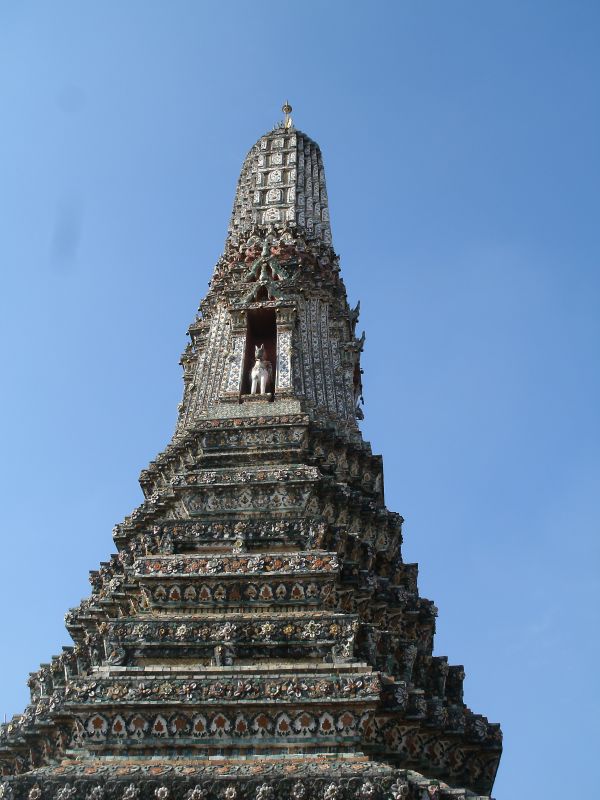
Here’s the top of Wat Arun. I have a lot more pictures, but, perhaps more than any other building I saw on this trip, Wat Arun was made completely of patterns, so the other pictures will mostly be in the second post.
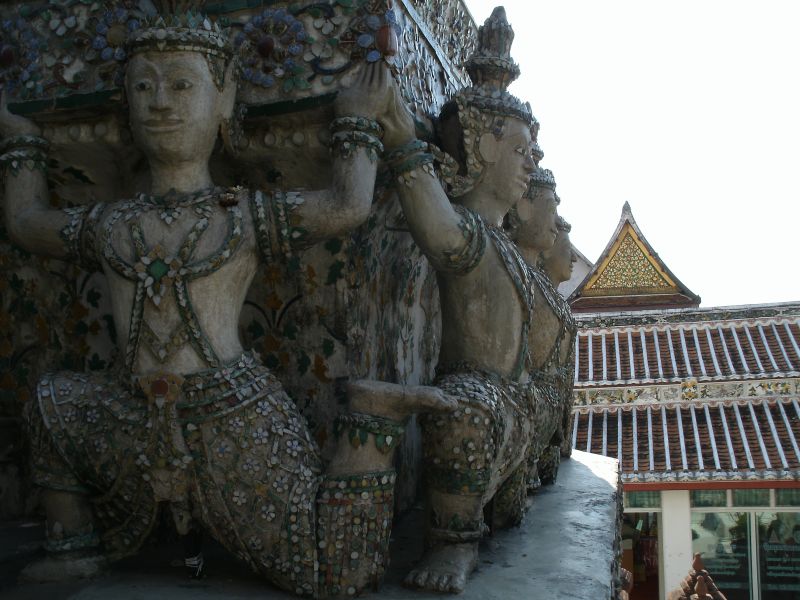
These creatures were all over the wat, holding up higher levels.
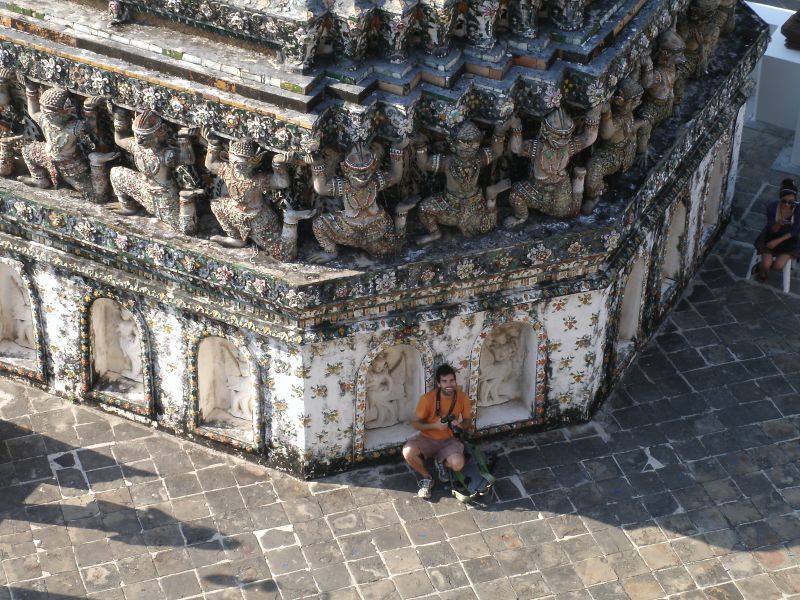
Here’s Glenn, still around.
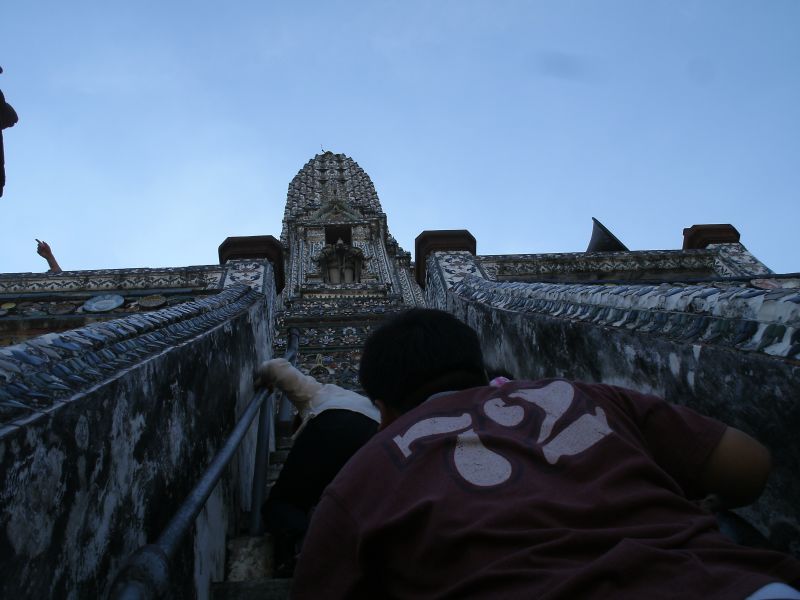
They build their staircases steep around here.
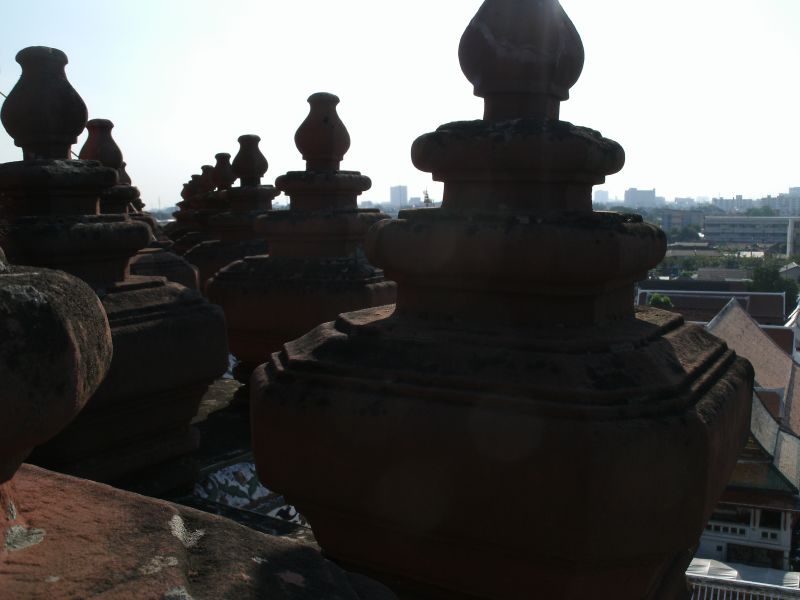
Up as high as I could get in Wat Arun, I took this not-the-greatest picture of a bunch of railing decorations. But you can tell how high up I am.
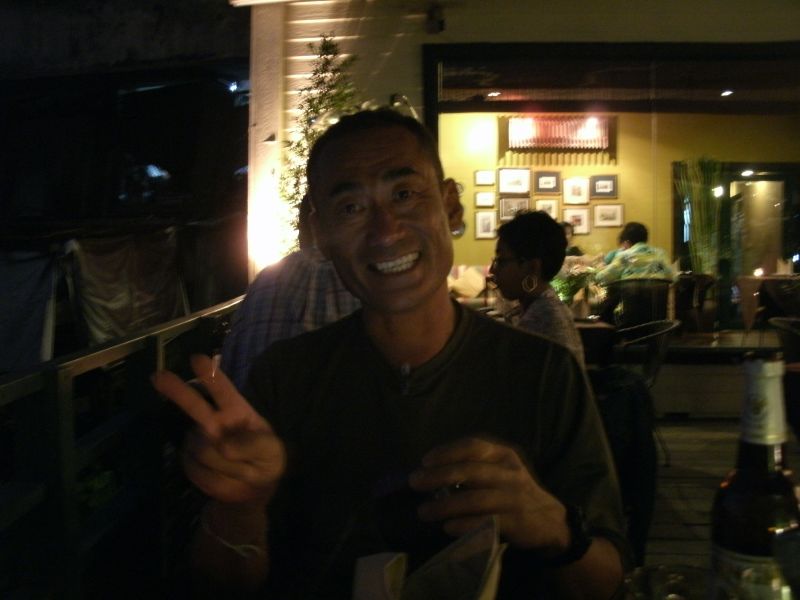
Here’s Mom’s friend Yoshi, who I met and had dinner with in the evening in Bangkok. With his hand he demonstrates that you can take the Japanese out of Japan, but you can’t take the Japan out of the Japanese.
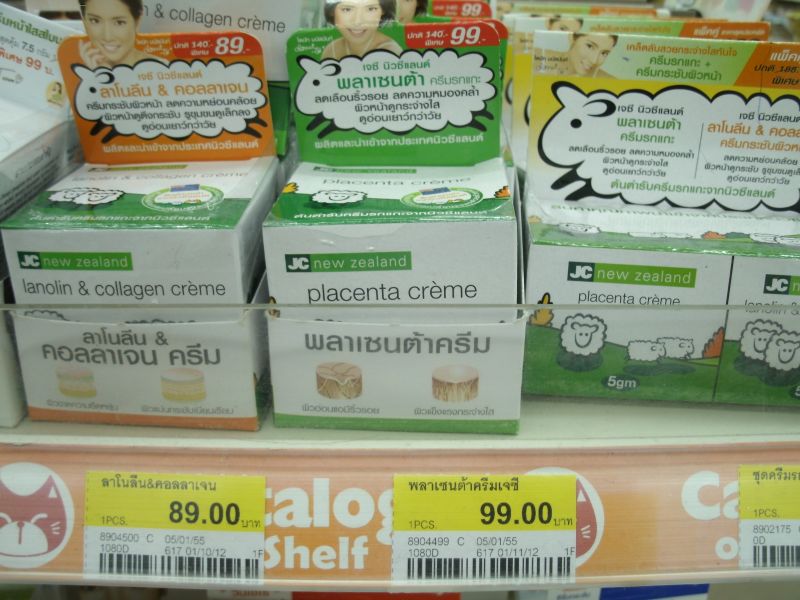
He took me to the bus station to get out of Bangkok. There, they were selling this enigmatic product.

The bus took me to Chiang Mai, and I got a tuk-tuk to a place right near the main city gates. There’s more city outside the gates than inside nowadays, but most of the coolest stuff is still inside. Having these walls took Chiang Mai, for me, out of the realm of the real, and made me feel like I was staying someplace fantastical. It’d be even more amazing if there weren’t so many neon signs and hipster coffee shops right next to it. What this place must’ve looked like before it became so full of tourists!
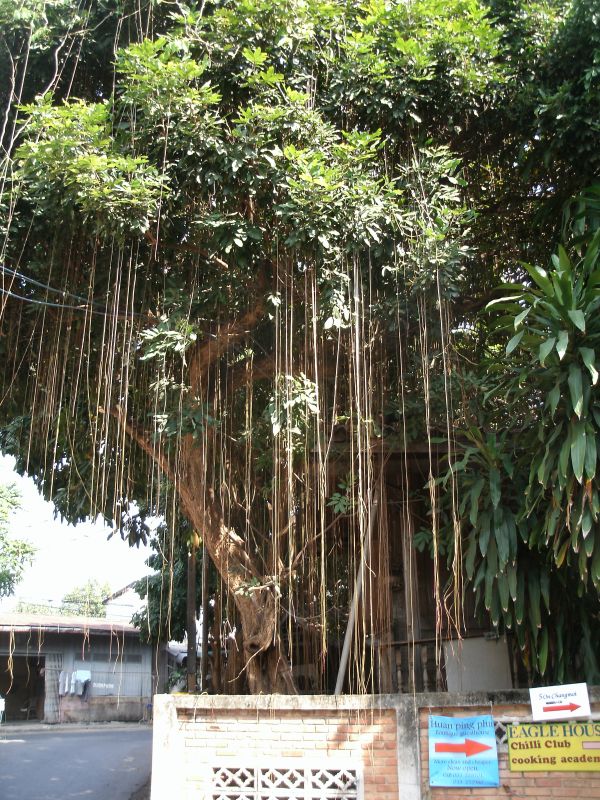
I quickly found a guesthouse with several massive tamarind trees. This one hung over the entrance. Another, bigger, one shaded the tables and lounging places in the yard. Its aerial roots hung down far enough that you could bat them around while lying around languorously.
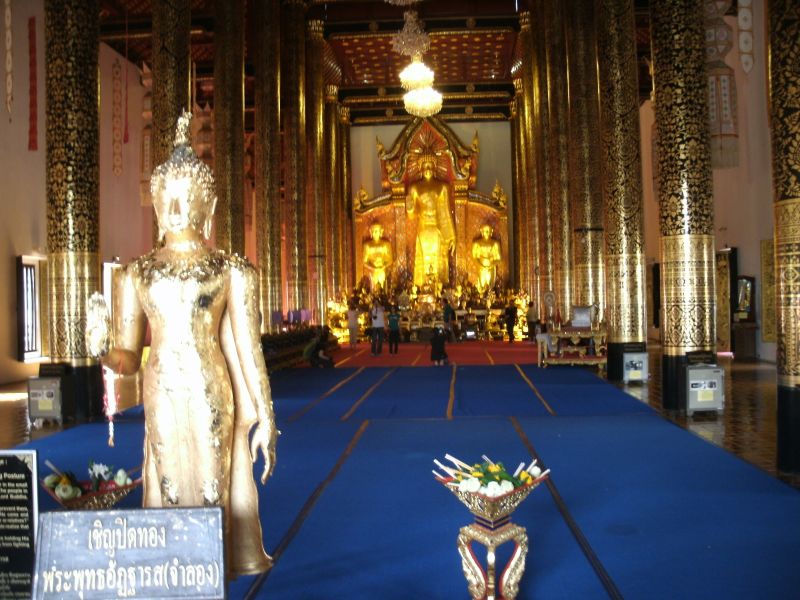
Chiang Mai is temple central for Thailand. All of them were beautiful.
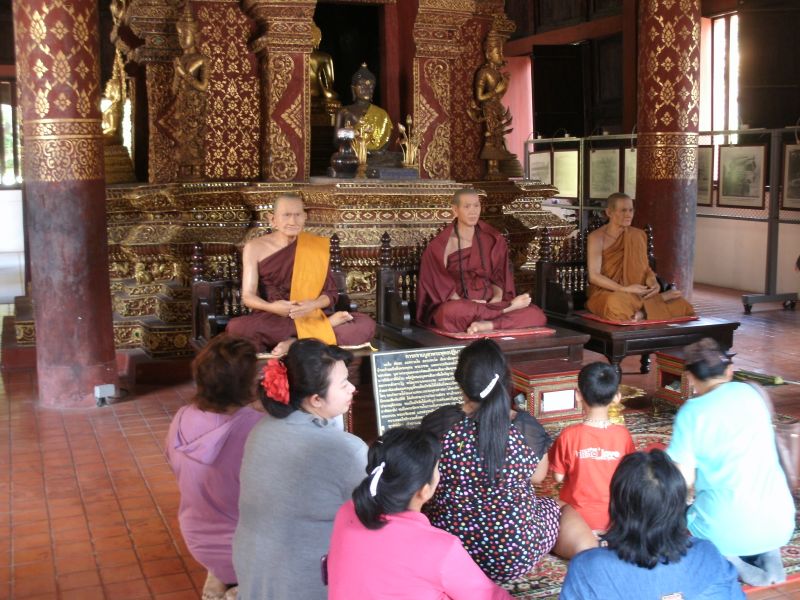
All appearances to the contrary, these three men aren’t real. I did a series of double-takes before I realized they were wax.
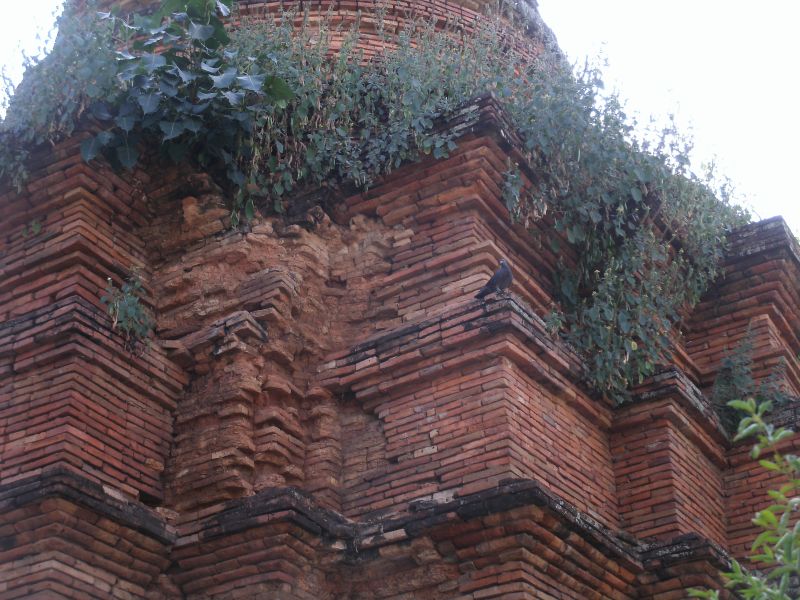
Somewhere, an old stupa in the city wall, or perhaps a standalone stupa, is taken over gradually by nature. This bird has pretty much the coolest home any bird could ask for. Well, except maybe the birds that live in Angkor Wat.
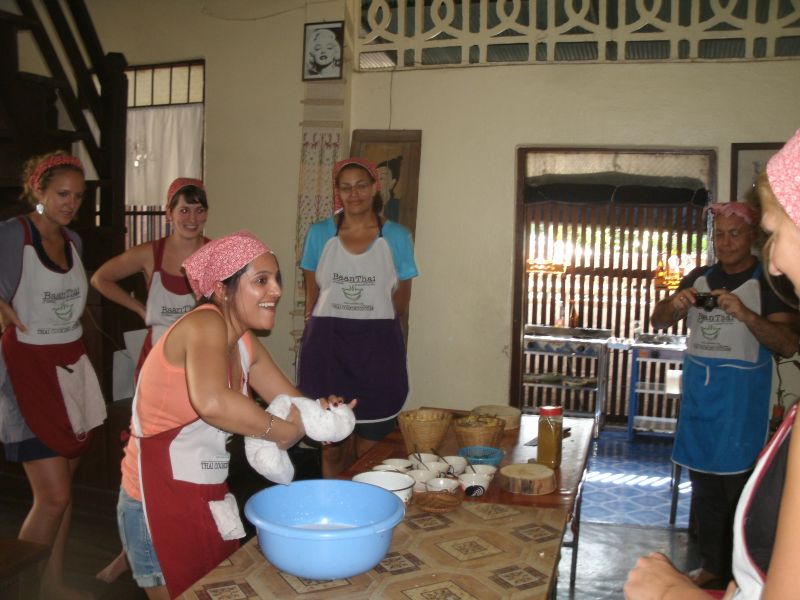
I didn’t take many pictures at my cooking class, but it was a pretty enjoyable time. We all got to take this mesh bag full of ground-up coconut and learn how to make coconut milk.
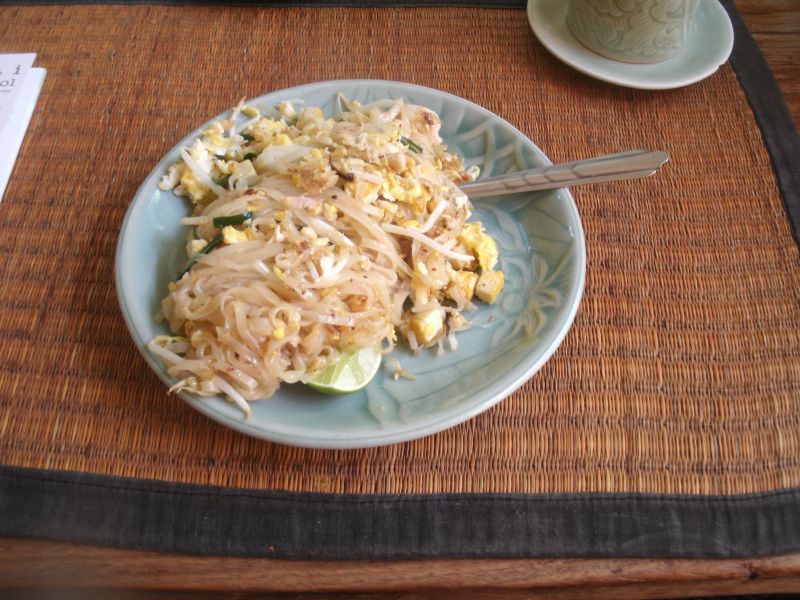
Since I made this one, pad Thai has rapidly become a staple of my diet.

Another day, I took a trip to Huay Kaew waterfall with H.

We were pleased with it.

On the way out, we were greeted by this selection of allegedly delicious insects and other arthropods.

Eventually I left Chiang Mai. My bus stopped on the way once and I took a picture of this, something that intrigued me but left me entirely flummoxed.

The bus left me at Chiang Khong, just across the Lao border from Huay Xai, where I got on the slowboat down the Mekong to Luang Prabang. The Mekong is not a gentle, lazy river. If it were a person, it would be a grizzled-faced old man with hands like boot leather.


But it’s friendly with its neighbors, at least.


I’m pretty sure there’s a hut hiding somewhere on this hill. But as far as the hill is concerned, it’s tiny enough that there may as well not be.

Arrived in Luang Prabang. It looks different from anywhere else in the world. I think you could show me a picture of just about any street in the city and I’d be able to tell that it was a Luang Prabang street.

It, like Chiang Mai, is full of temples.

But of course there’s other stuff, like markets. Several of them, in fact; this one is the morning market.

These cages each contain two little live birds. You take them to a temple and let them free. I don’t know what it signifies, but it seems like a really quaint, interesting ritual.

Now that I know how to cook fish, this looks delicious to me.

I think this is a place where they were carving Buddha statues.
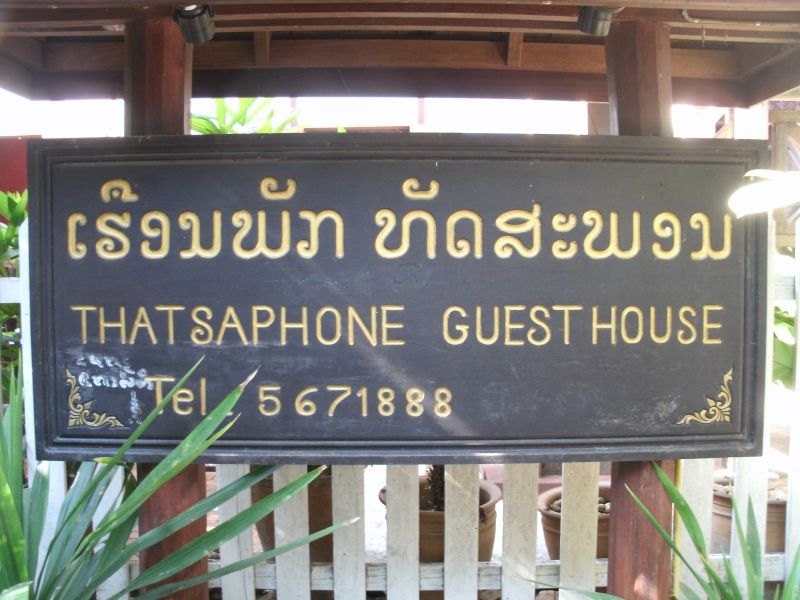
There were a few peculiar little things about Luang Prabang. This guesthouse seemed like they must’ve named it with a phrase randomly picked from their English textbook. Unfortunately, when you say it out loud properly, it’s less funny because it’s more like taat-sa-pone.
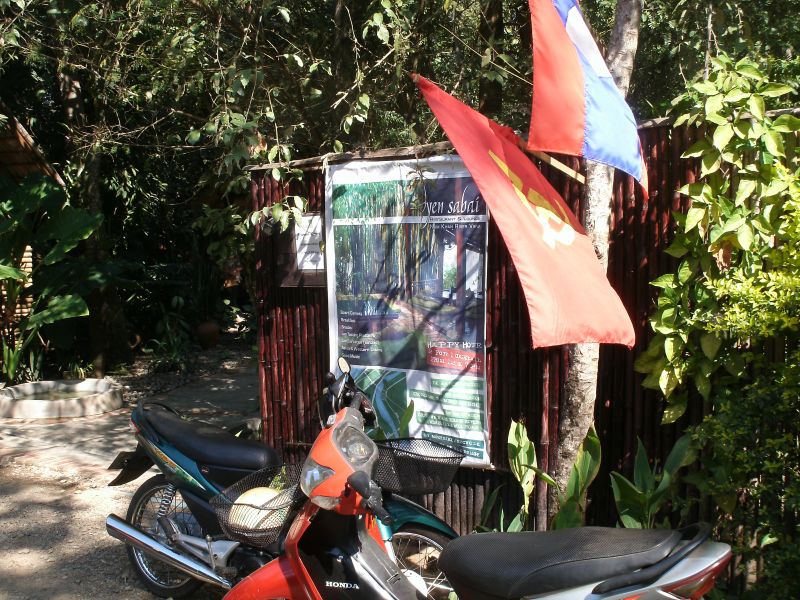
And they fly Communist sickle-and-hammer flags all over the place. This one is next to a rather capitalist-seeming bar.
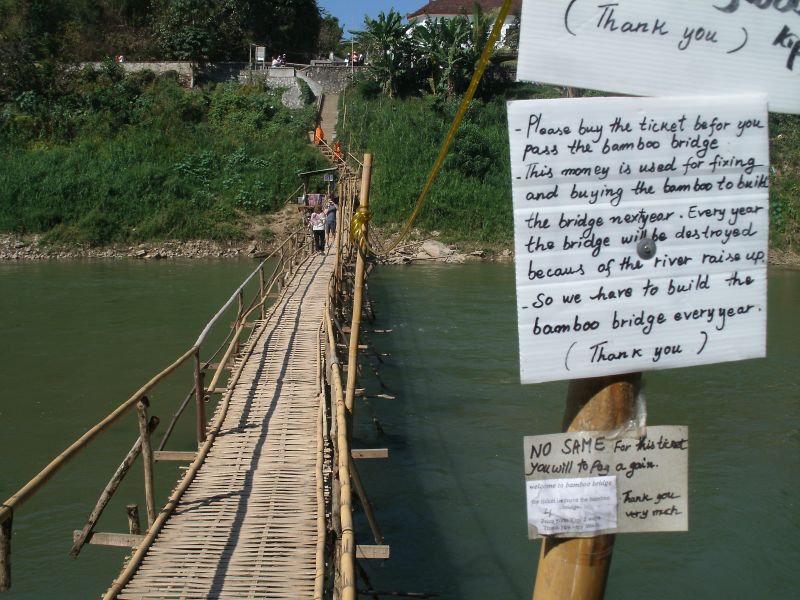
And here’s the bamboo bridge that they rebuild every year.
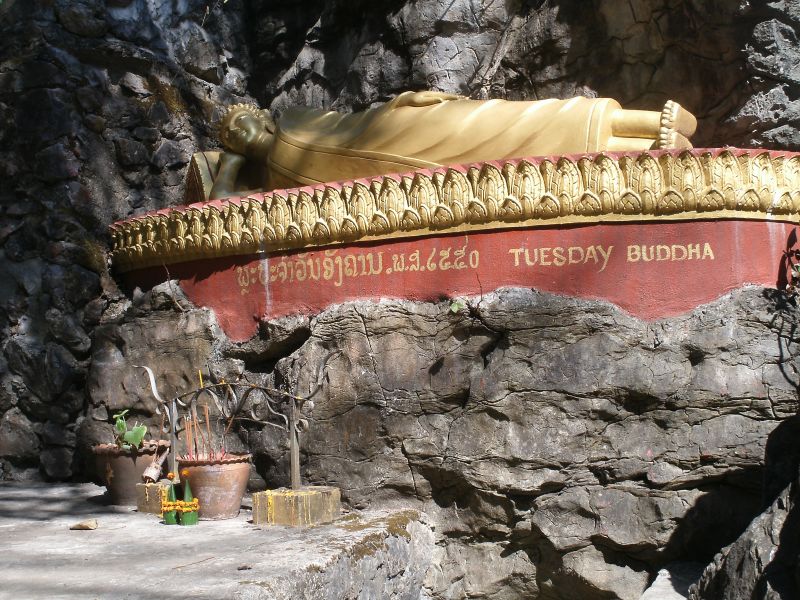
I climbed up Mount Phou Si in the middle of the old town, where they have their most visible and (I think) most meaningful wat, Wat Chom Si. All along the path up were Buddhas from various days of the week (or with other names), in different poses, none of which lore I understood.
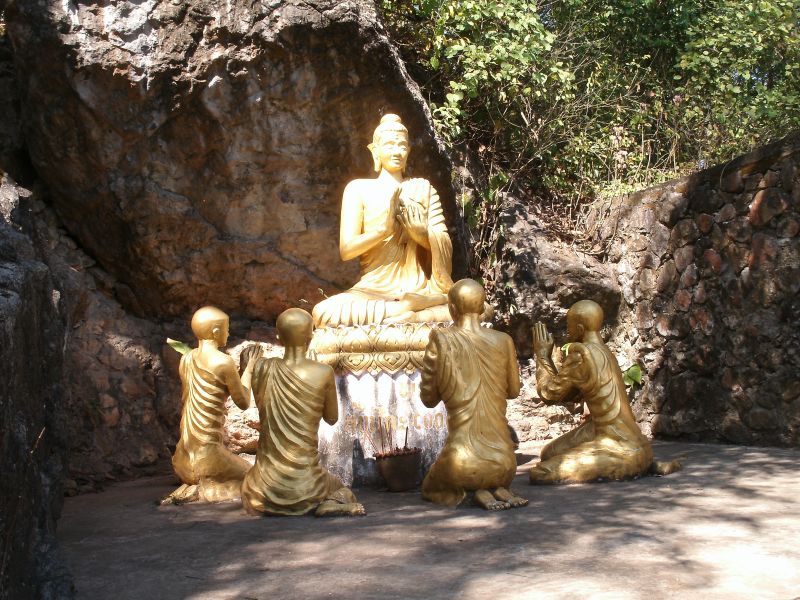
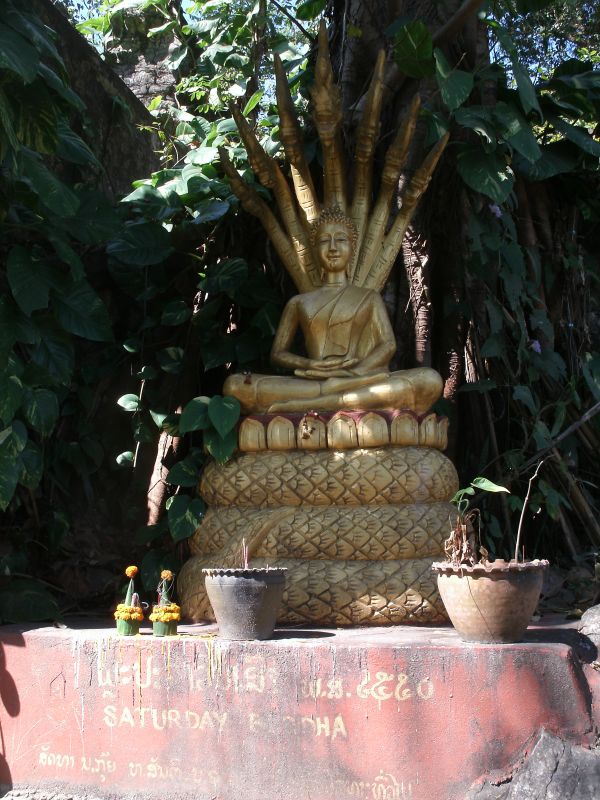
Saturday Buddha.
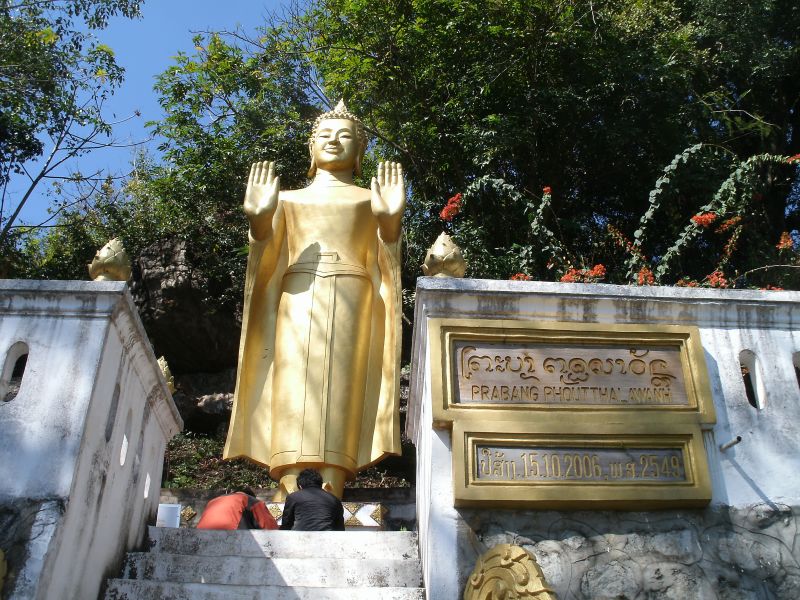
Prabang Phoutthalawanh, whatever that may mean, with worshipers.
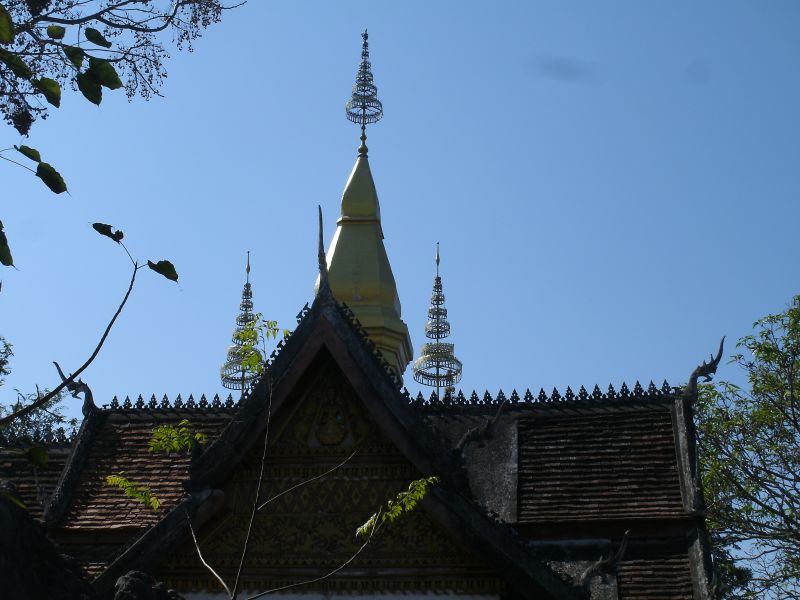
And here we are at Wat Chom Si itself. I didn’t take many pictures because I was too distracted by the view (picture at this post—I’ve decided not to duplicate here any pictures I already posted).
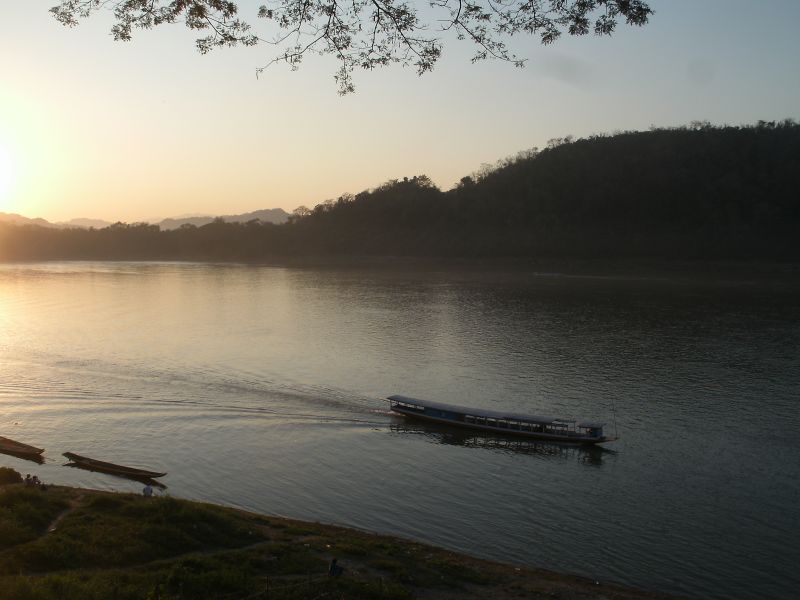
A sunset seen from a Mekong-side deck restaurant is one of the better experiences this life has to offer.
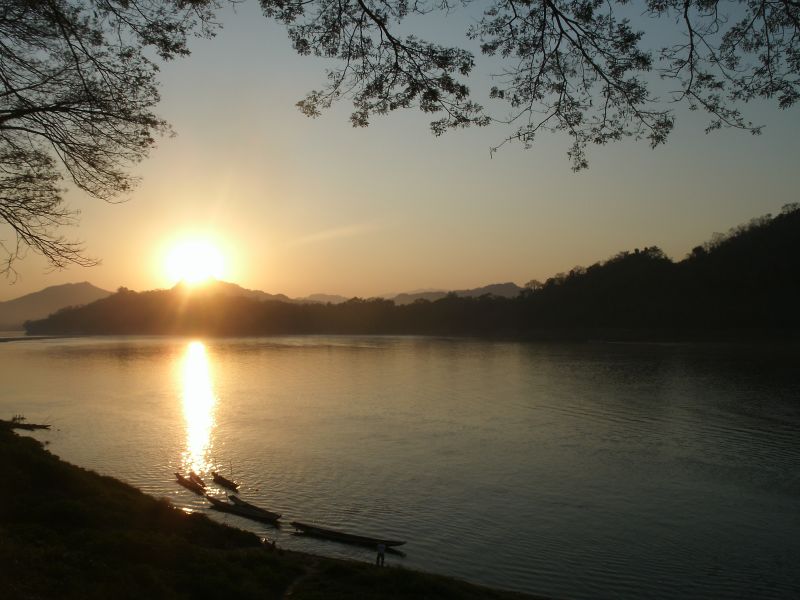
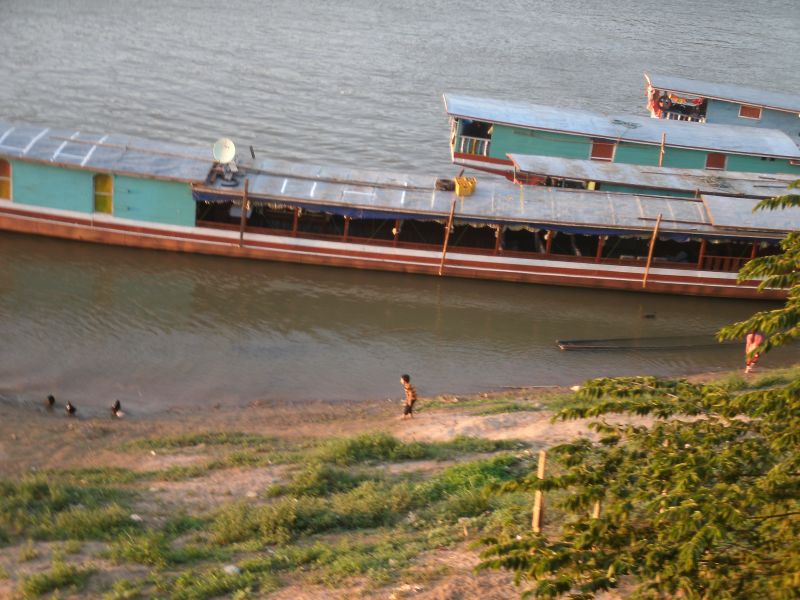
Down below the restaurant were kids playing in the water. Those boats are the same kind I traveled in from Huay Xai.
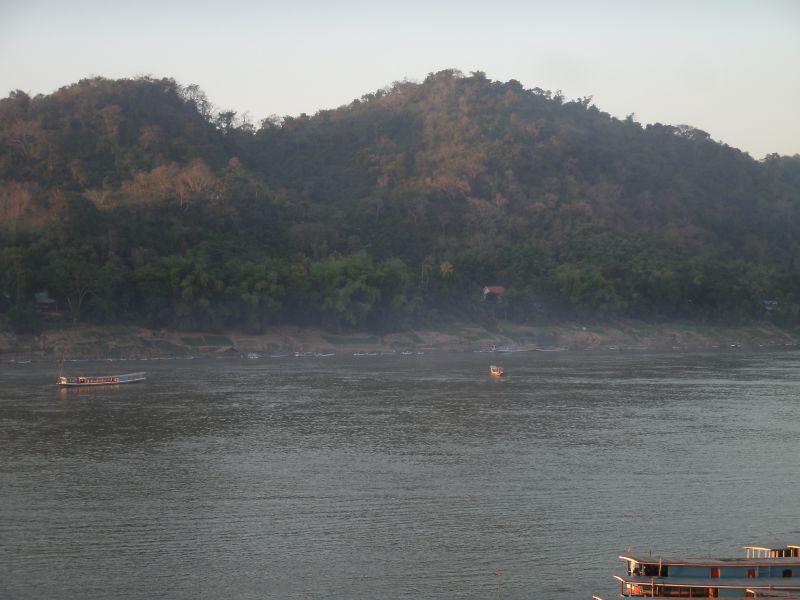
The place is magical, I tell you.
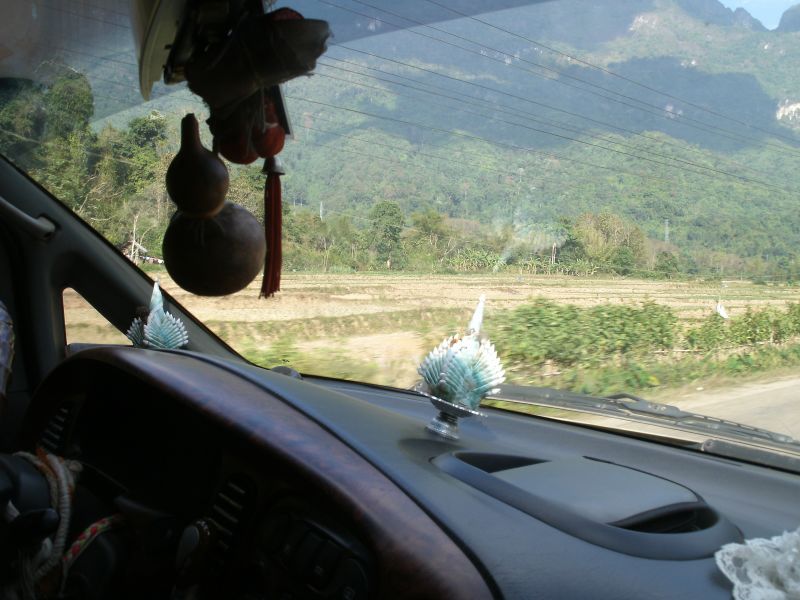
I took a “minibus” from Luang Prabang to Vang Vieng. It turned out to be a minivan. To cope with Lao roads, every driver takes along some good luck charms—for instance, lotuses made of folded Lao money.

This picture and the next few are why karst topography is awesome.
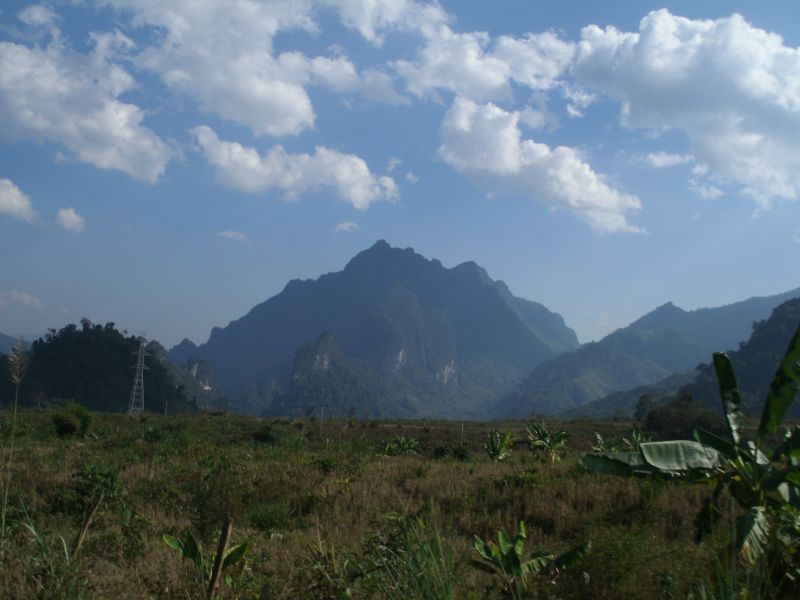
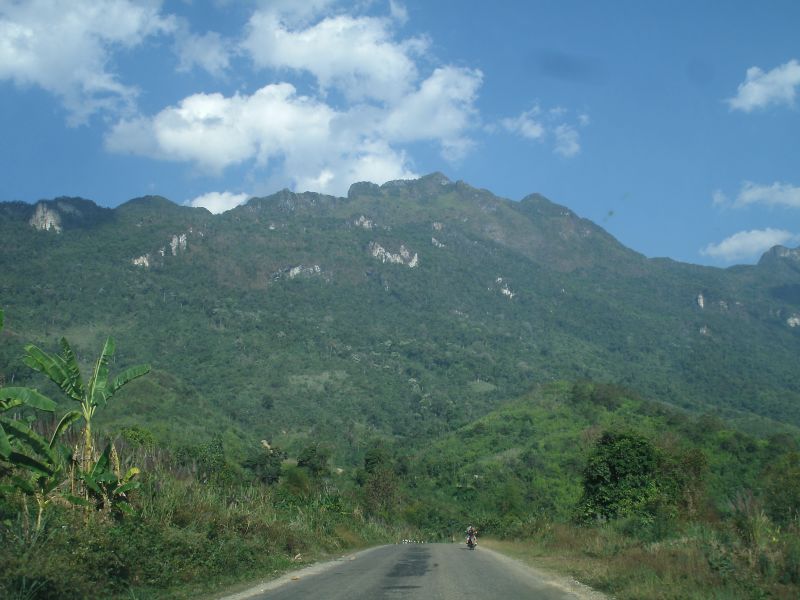
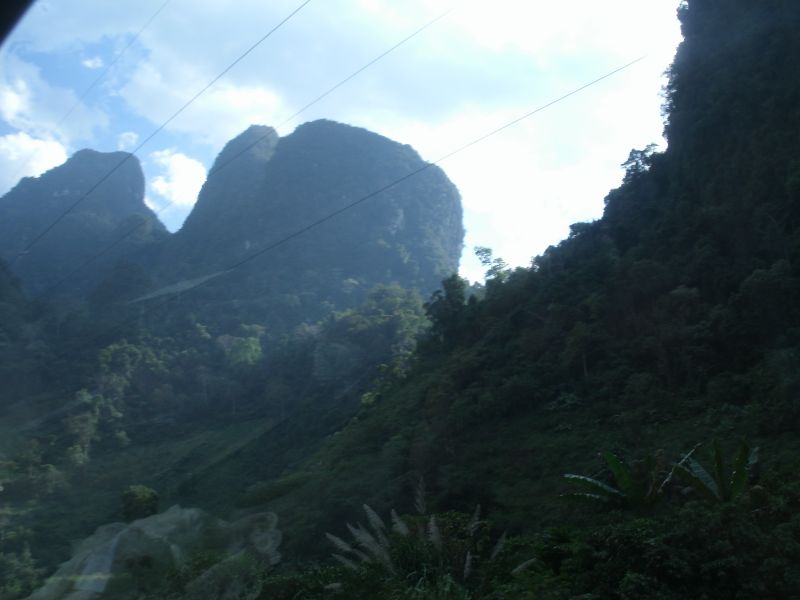
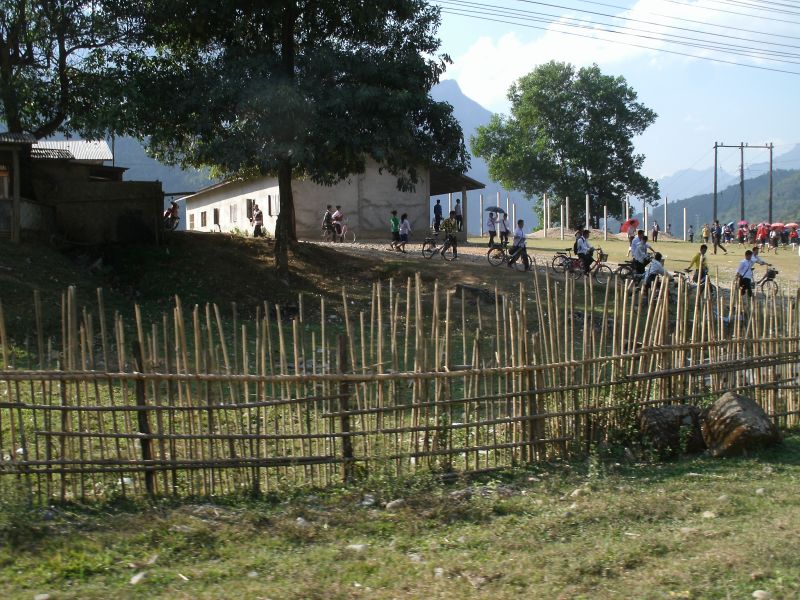
Besides karst, I also saw a clutch of kids getting out of school.
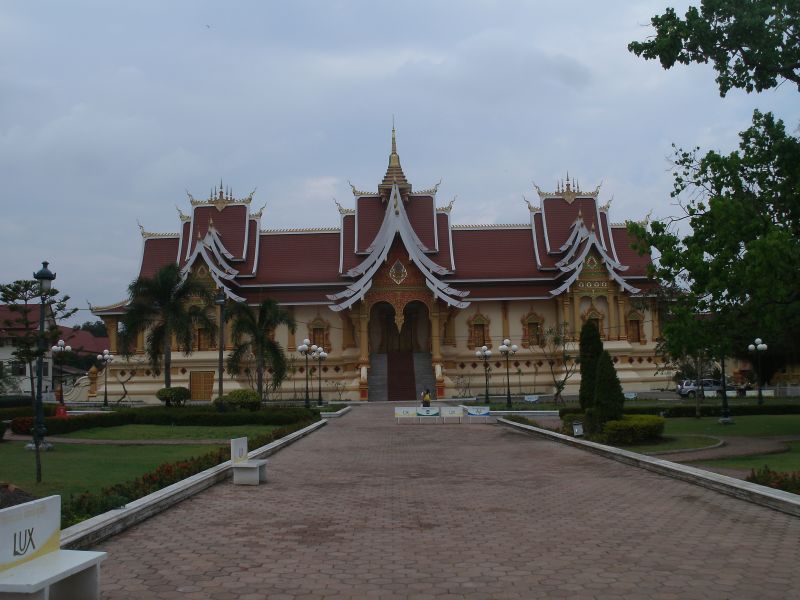
Apparently I didn’t actually take any pictures in Vang Vieng; I don’t remember if I kept forgetting my camera or if it was refusing to turn on or if I was too demoralized by the bacchanalia around me. So this picture is from a few days later, when I got to Vientiane. It’s a pretty modest capital city, and I’m not sure what this building is, but it might be the most ostentatious thing in the city.
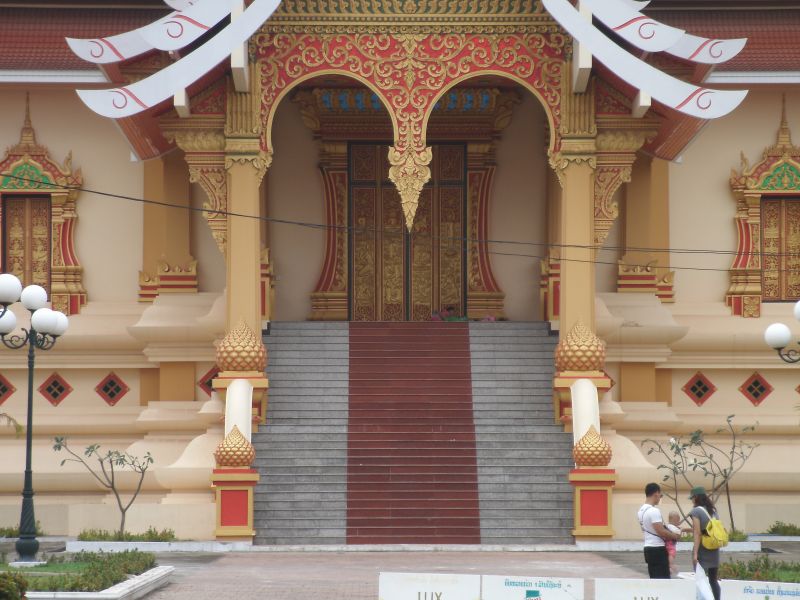
I was gratified to note that there were kids wandering around on its front steps.
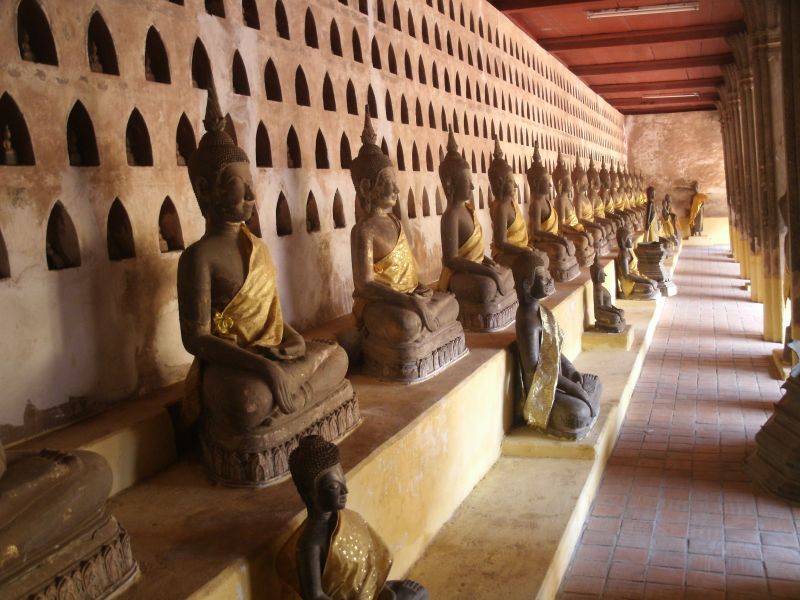
There’s also the Wat Si Saket, with several thousand Buddha images. Each of those little cavities on the wall has not one but two tiny seated Buddhas in it.
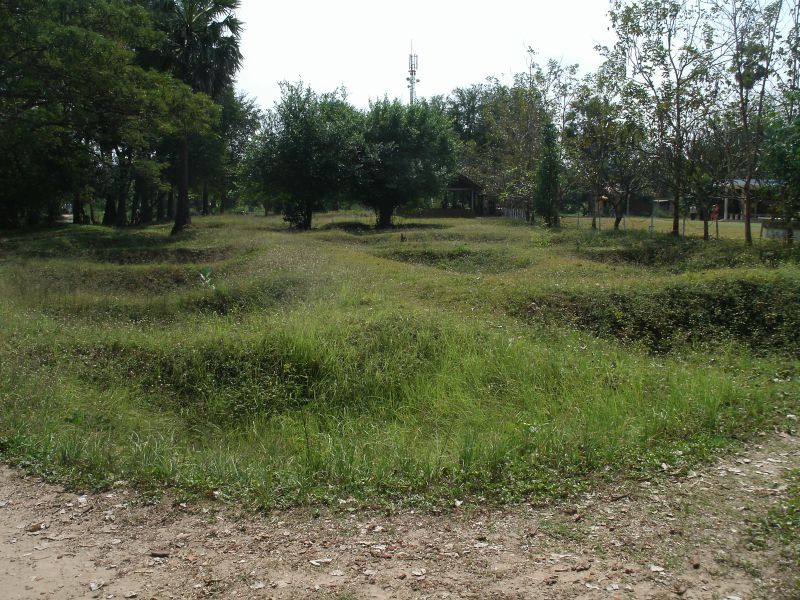
After some intensive bus-riding, I got to Phnom Penh, and in the morning went to the Chœung Ek Killing Fields. This was one of the biggest killing fields, but by no means the only one. Yet even just here the brutality was devastating even to view from over thirty years’ remove. Each of these pits, I believe, was a mass grave.
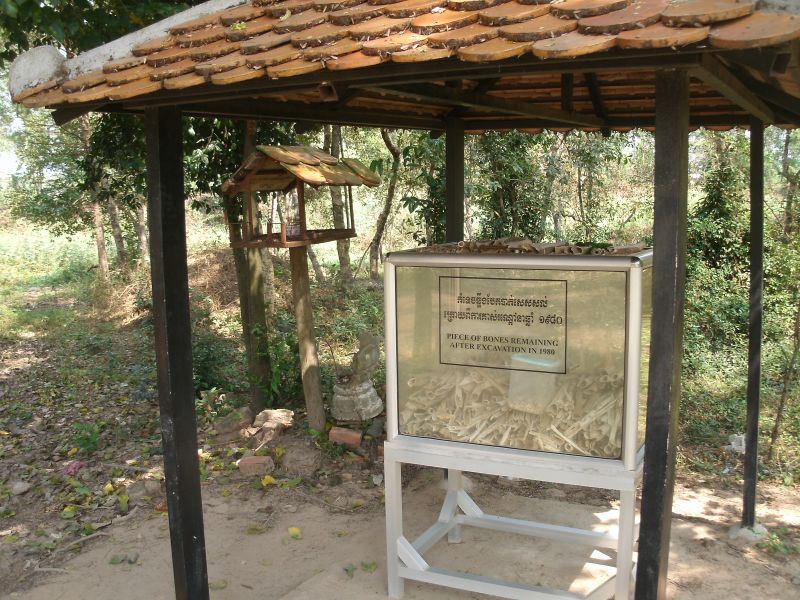
In the glass box are bones that were found when they did a comprehensive clean-up of the site some years back, having already dug out all the mass graves. But people are still finding bones even now, and when they do, they pile them on top of the box. There was another box like this full of victims’ clothes. I was pretty sure I saw a scrap of clothing along one of the paths in the pile of dirt, but I didn’t pick it up to put it on top of that box.
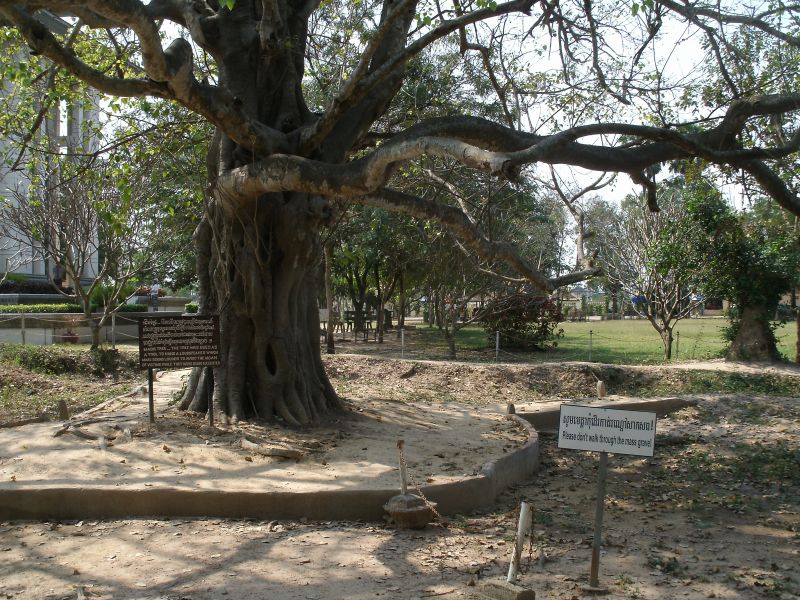
The sign on the right says, “Please don’t walk through the mass grave!” The sign on the left says: “Magic Tree… The tree was used as a tool to hang a loudspeaker which make sound louder to avoid the moan of victims while they were being executed”. To clarify, the sounds being amplified were propaganda songs glorifying the Angkar and the Khmer Rouge, and when they say “avoid” they mean “drown out”. In the last stop on the audio tour, there’s a recording of what this would’ve sounded like when mixed with the drone of a Diesel engine that would’ve been running nearby—the last sounds victims here would’ve ever heard. It was haunting.
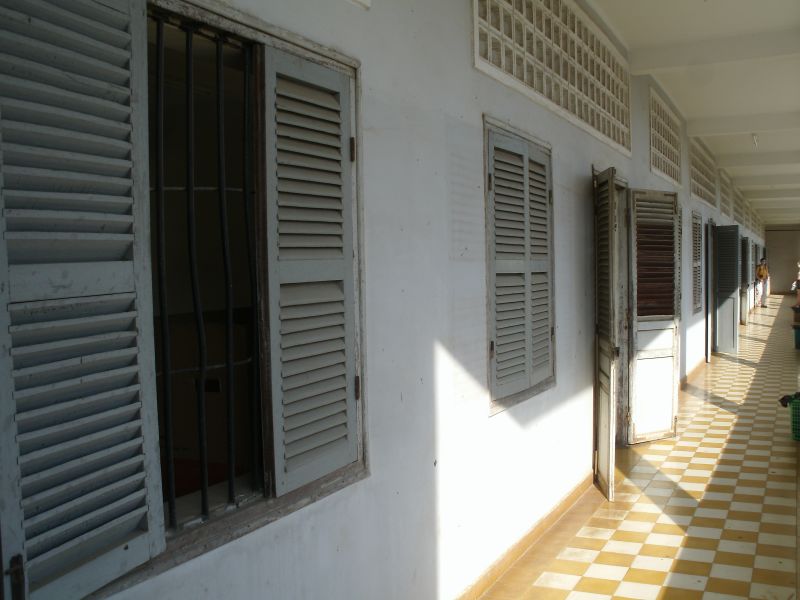
Back in the city, I went to Tuol Sleng prison, where people were kept before going to Chœung Ek. It used to be a high school.
In each of these rooms is an exhibit about what happened back then.
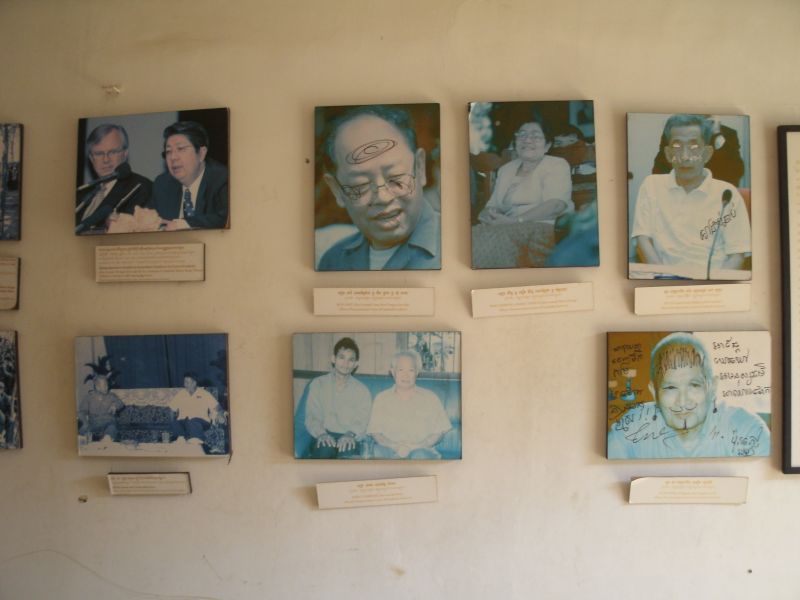
For example, in here are pictures of the people who made all the death happen. Appropriately, the pictures have been defaced, presumably by people who lost family or friends.
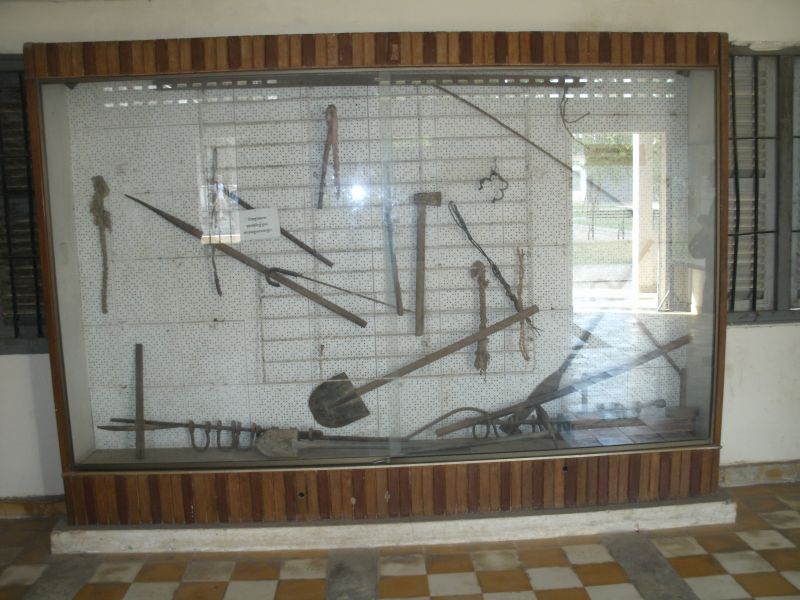
In this room are farm implements that were pressed into service as killing tools.
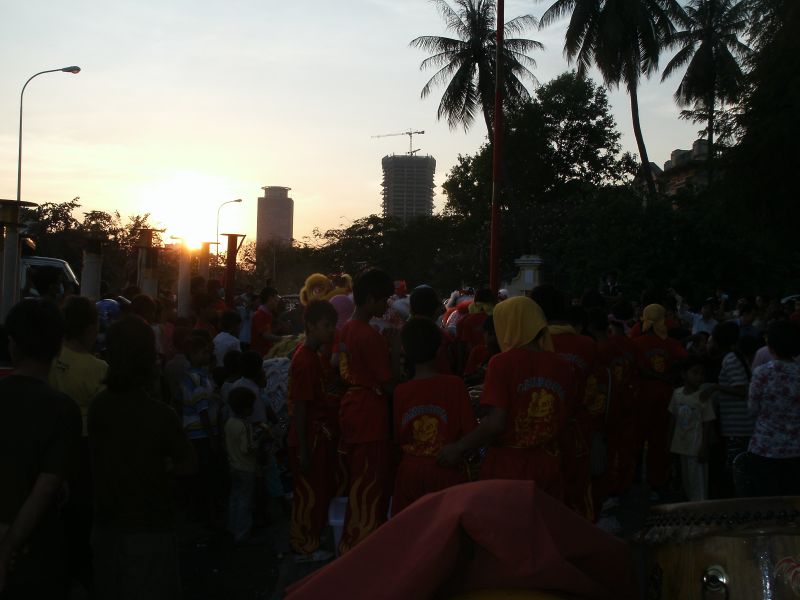
Unfortunately, I didn’t really take many pictures, or any good pictures, of the parts of Phnom Penh that aren’t given over to gloom and death. Those are of course far more numerous, but I wasn’t as prepared to find them, I suppose. At any rate, here’s a group of people celebrating Chinese New Year, who I witnessed as they came out of a building, finished dancing animatedly, and then packed up their stuff and got on a truck to go to the next place that needed a Chinese New Year celebration.
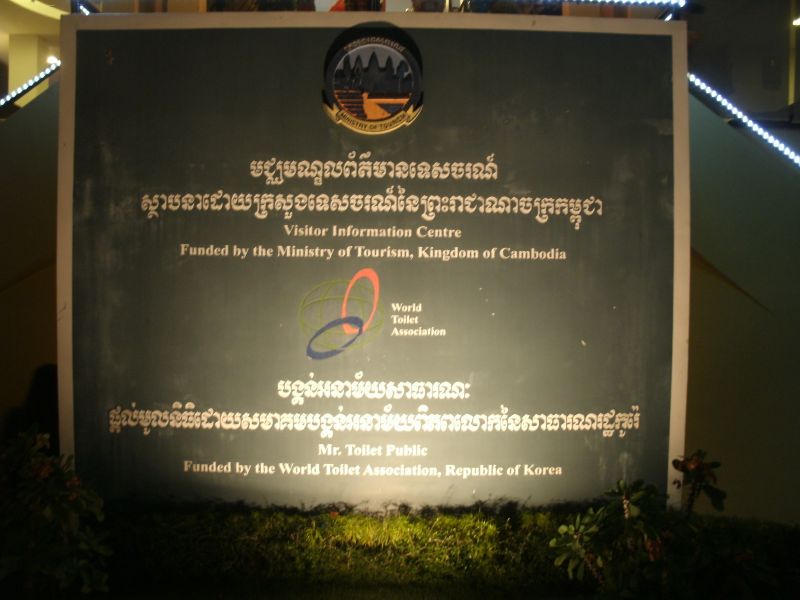
I went to a riverside walk lined with flags from every country in the world and had beer with a friendly Belgian girl while watching the cars go by on a main city thoroughfare lining the river, and yet the only thing I took a picture of there was this sign that says enigmatically, at the bottom, “Mr. Toilet Public / Funded by the World Toilet Association, Republic of Korea”.
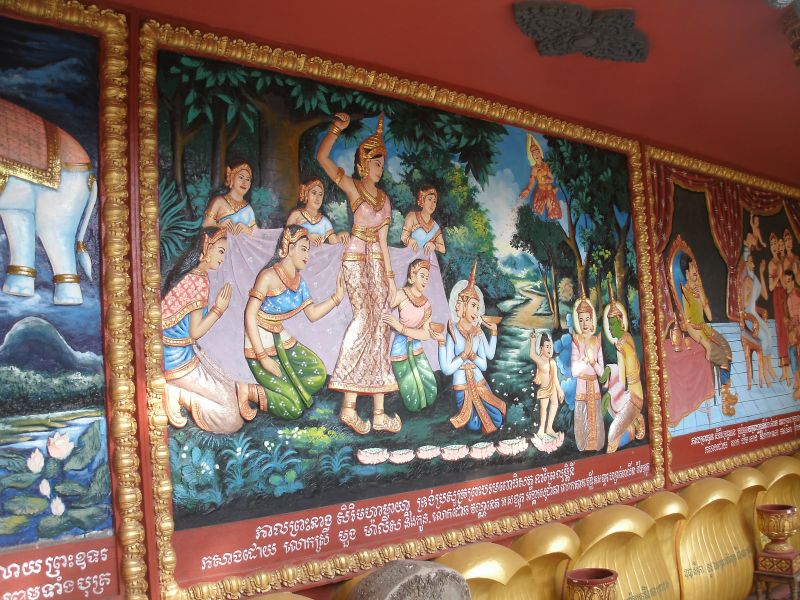
I left Phnom Penh and arrived in Siem Reap. This was probably the most well-kept temple I saw during my whole journey. Its courtyard walls were covered with these very well done bas-reliefs.
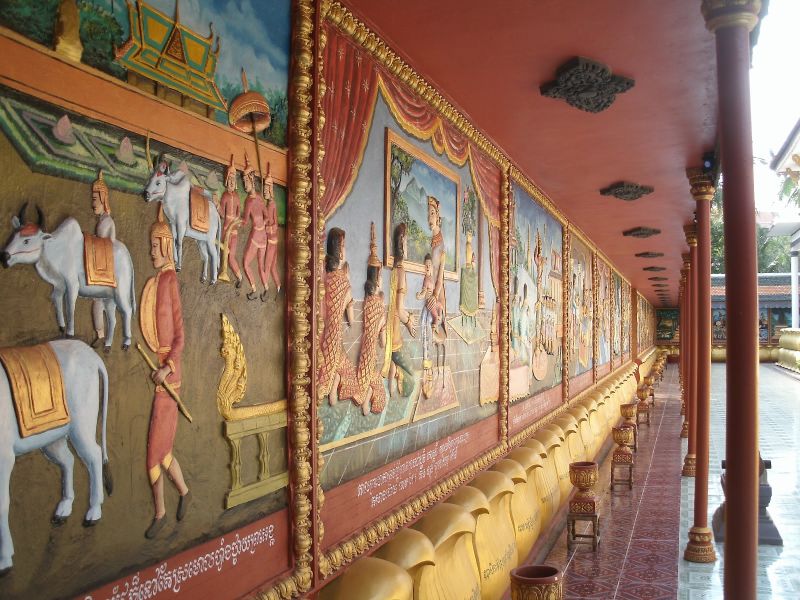
Dozens of them.
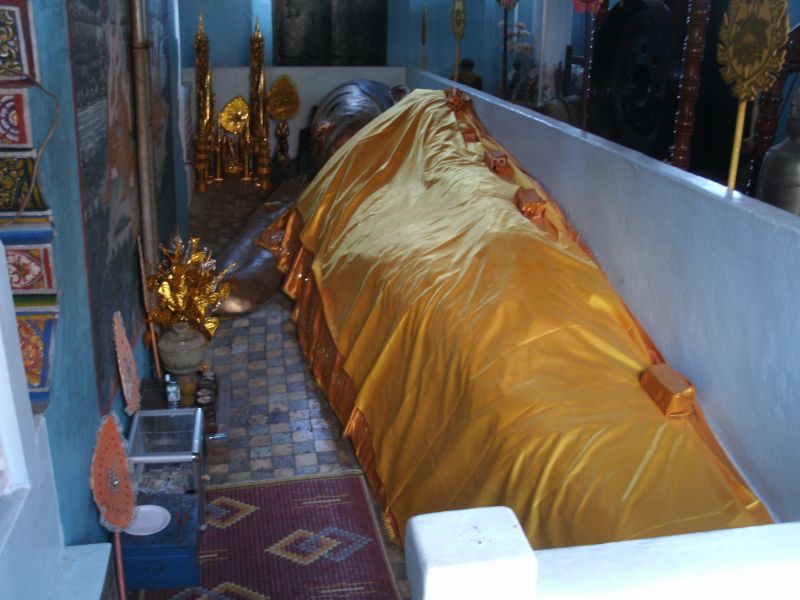
Inside the courtyard was a building housing two Buddhas—a typical seated one, and this one that’s apparently been sinking into the ground under its own weight since it was made long ago out of a legendary monk’s canoe’s hull.
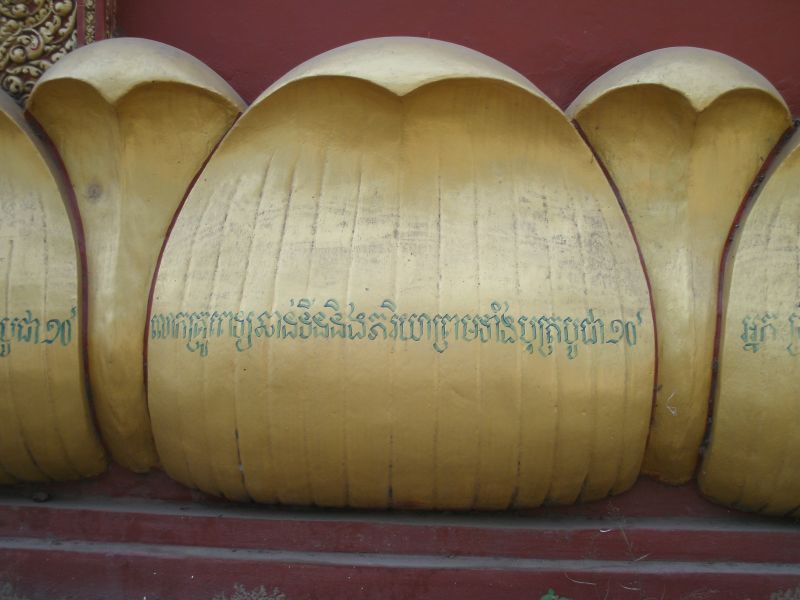
As far as I can gather, these lotus petals each say the name of a donor and how much they donated. For example, at the very end, you can see that this donor gave US$10. (They use different numerals in Cambodia. Their 1 looks like a 9. Here’s what they look like.)
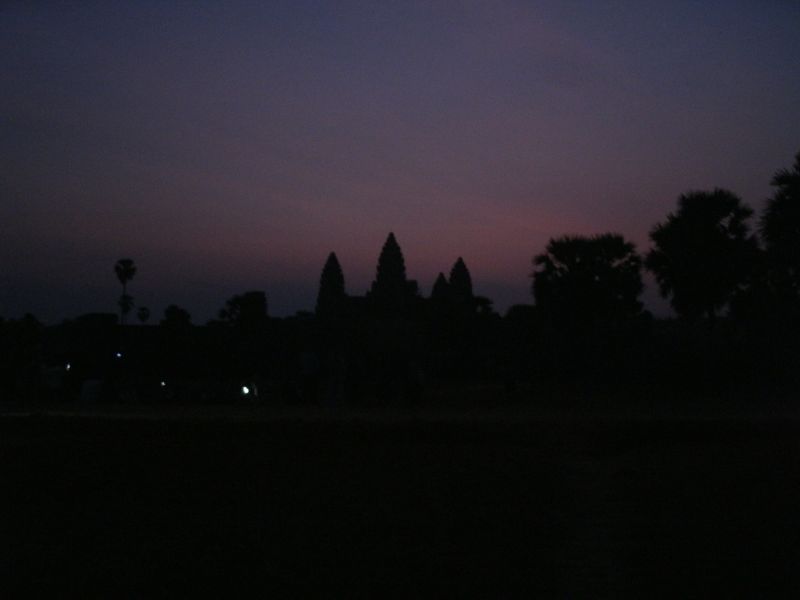
The next day I got to Angkor Wat. The sun rises behind it.

There are tourists aplenty.
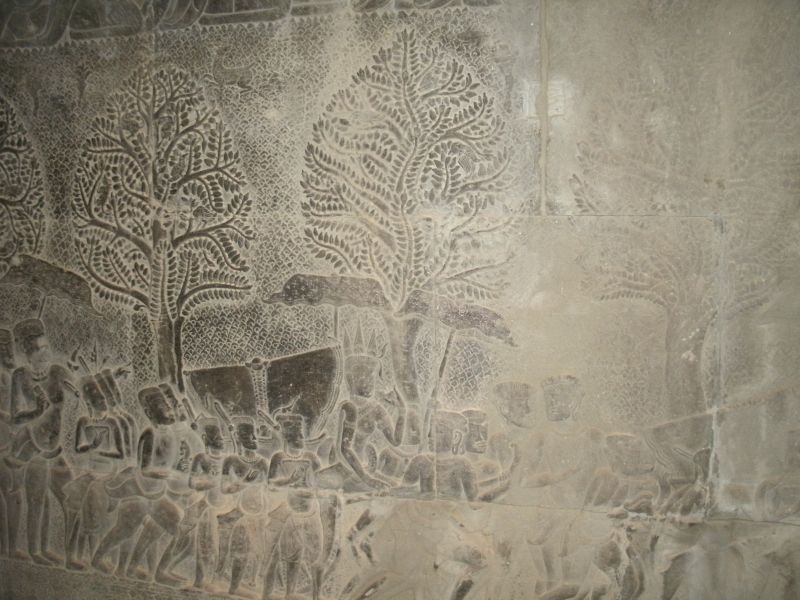
The outside walls have these tremendously detailed bas-relief stories.
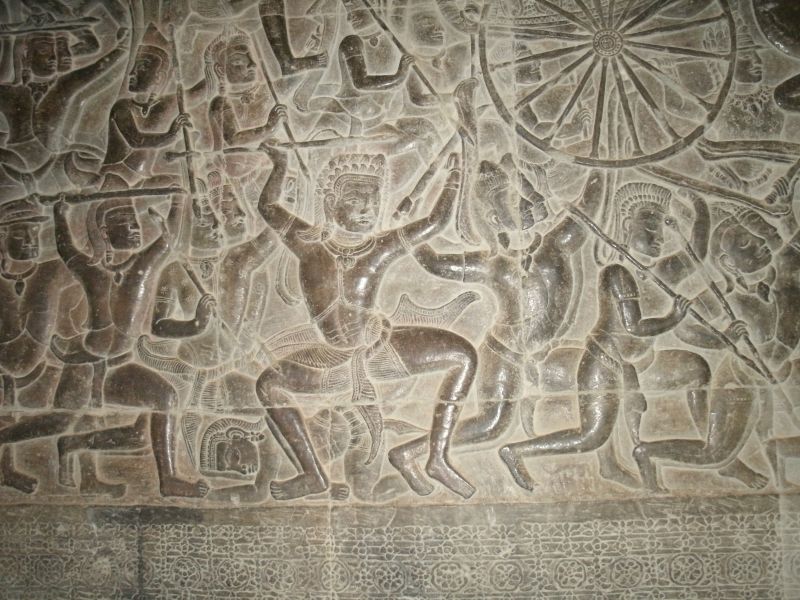
I don’t know the story, but whatever it is, it looks like these carvings tell it pretty well.
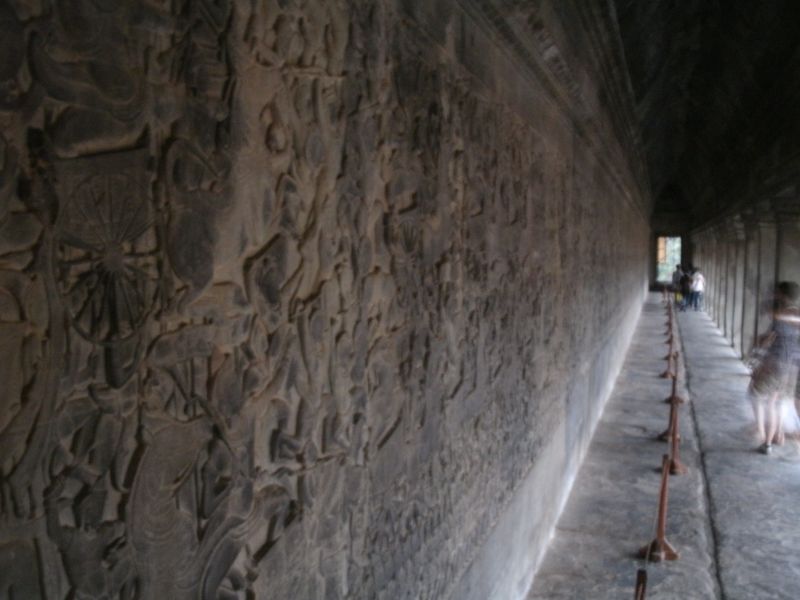
And at length.
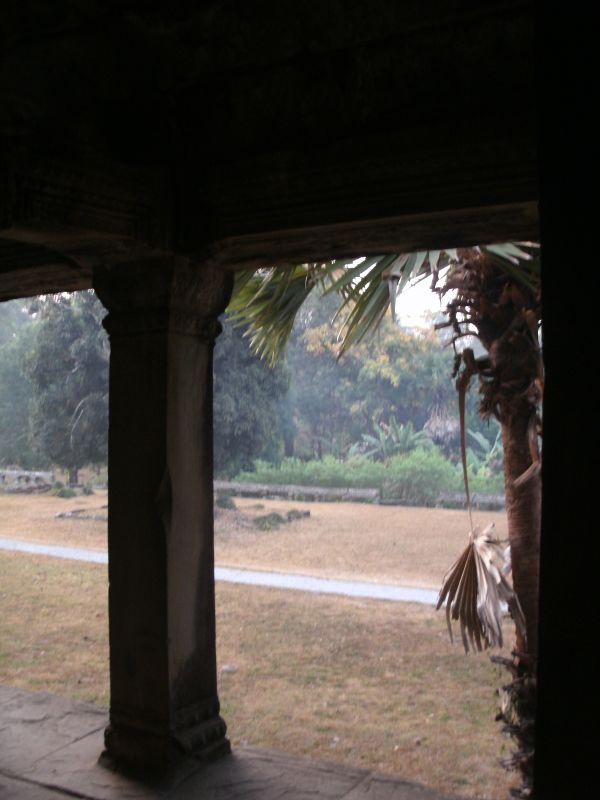
Opposite the carvings is the jungle.
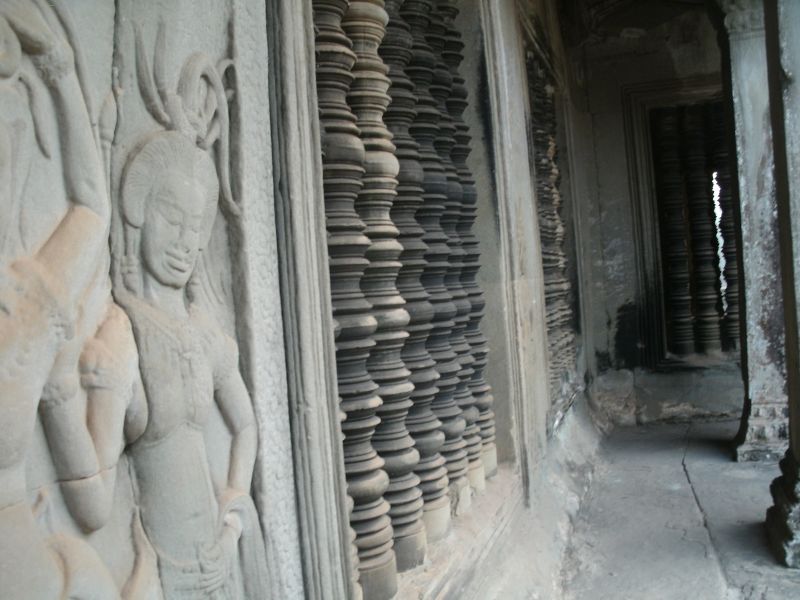
It’s been bouncing light onto these carvings and columns for centuries.
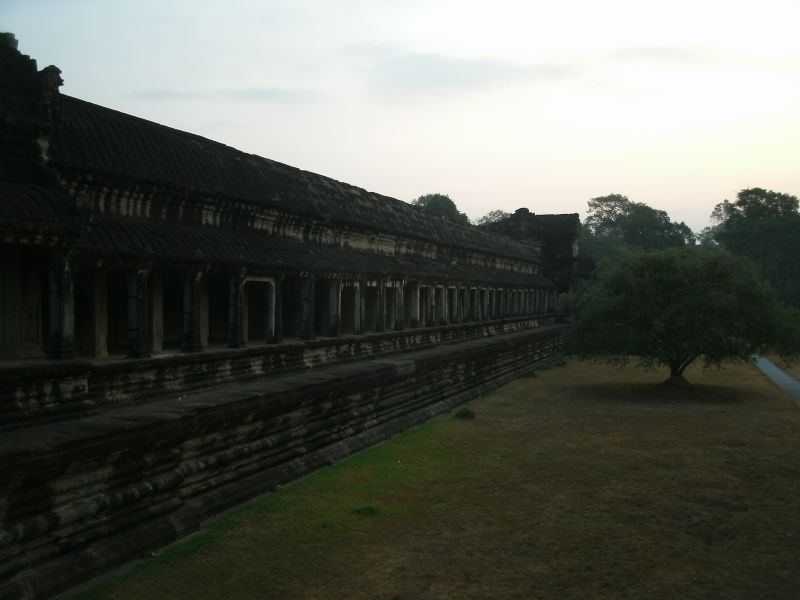
What the carvings’ corridors look like from outside.
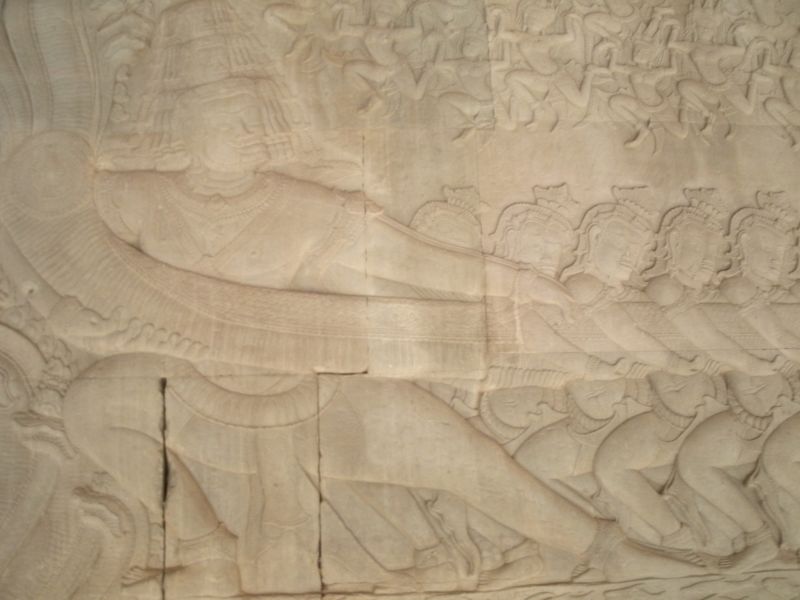
Here’s another story, apparently about a god with many heads wielding a tremendously long battering ram with the help of about a hundred soldiers.

There’s a stupa in the lawn of Angkor Wat.
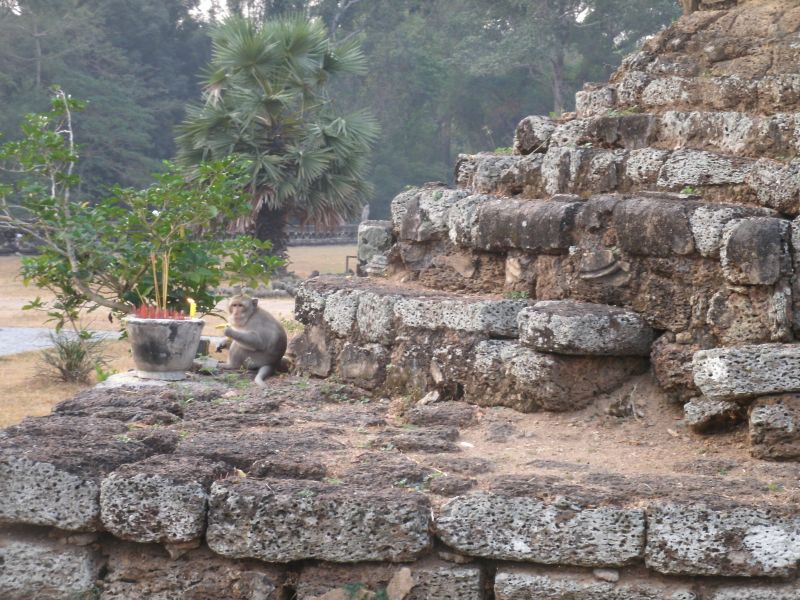
On the stupa offerings are left for the Buddha. A monkey gladly accepts them as his proxy.
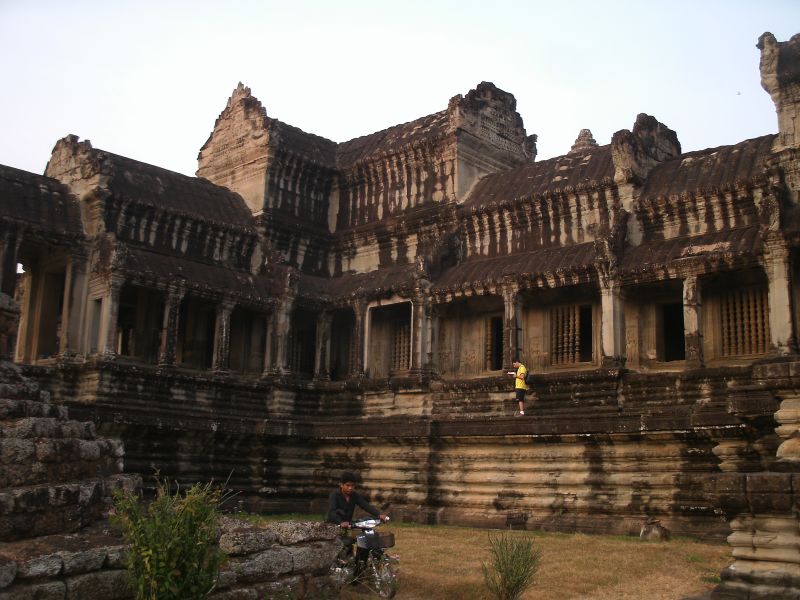
On the left is that same stupa. This is a view of one of the several entrances to the temple.
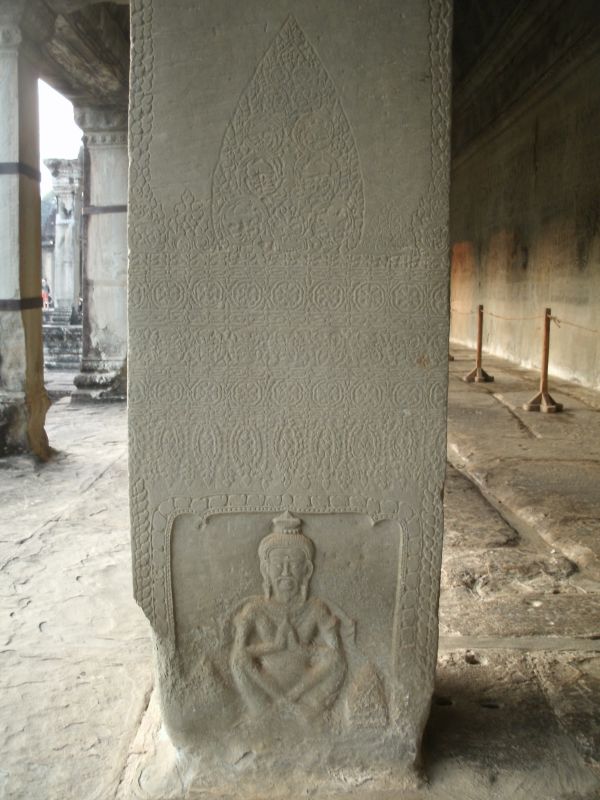
They left nothing undecorated. Every column is adorned with, at a minimum, this much carving.
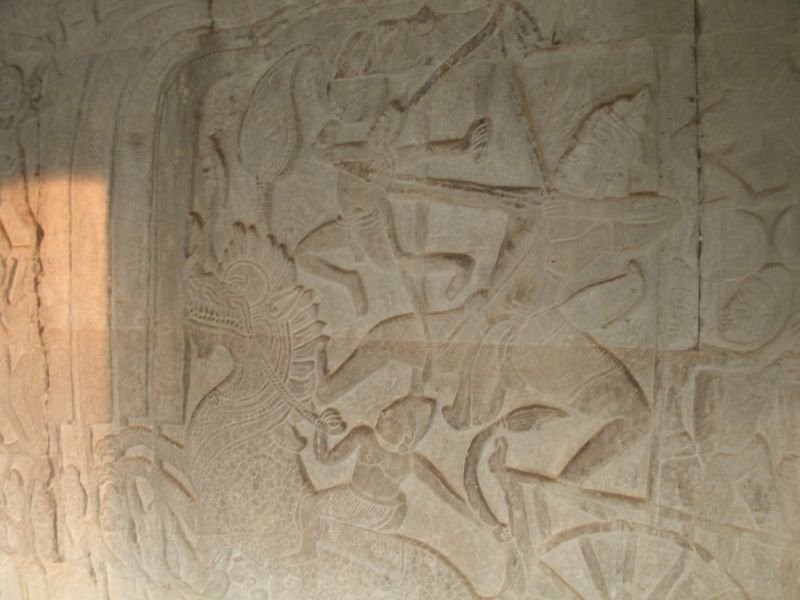
More carvings.
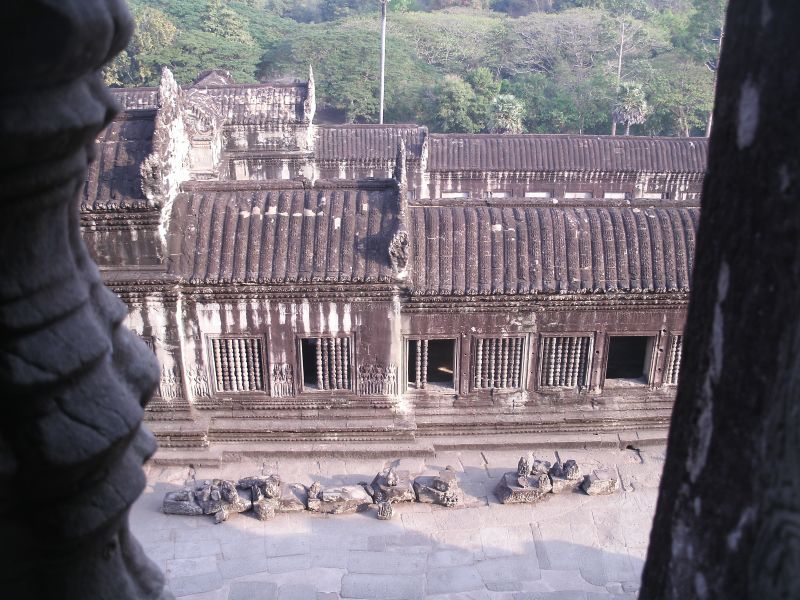
I got farther into the temple and eventually got to the top, or at least as high as anyone’s allowed to go. It’s pretty high up.
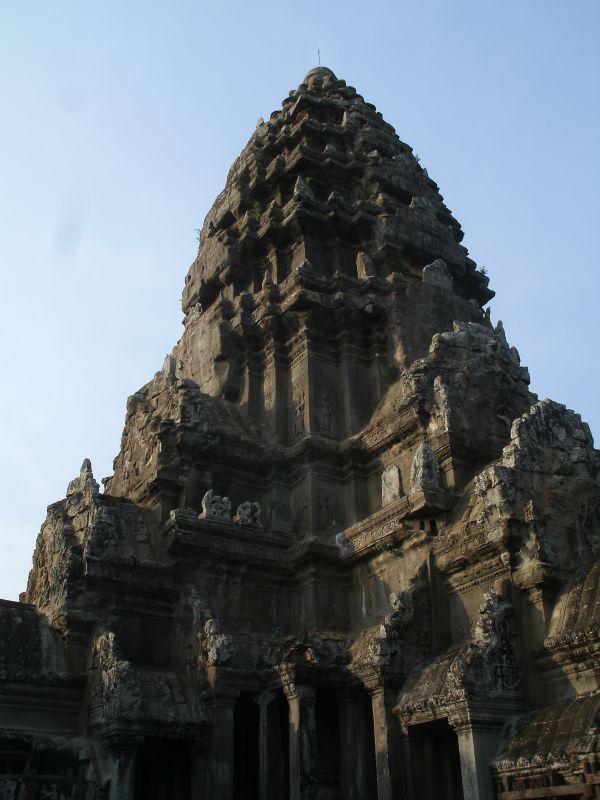
But the giant lotus flowers are still higher up.
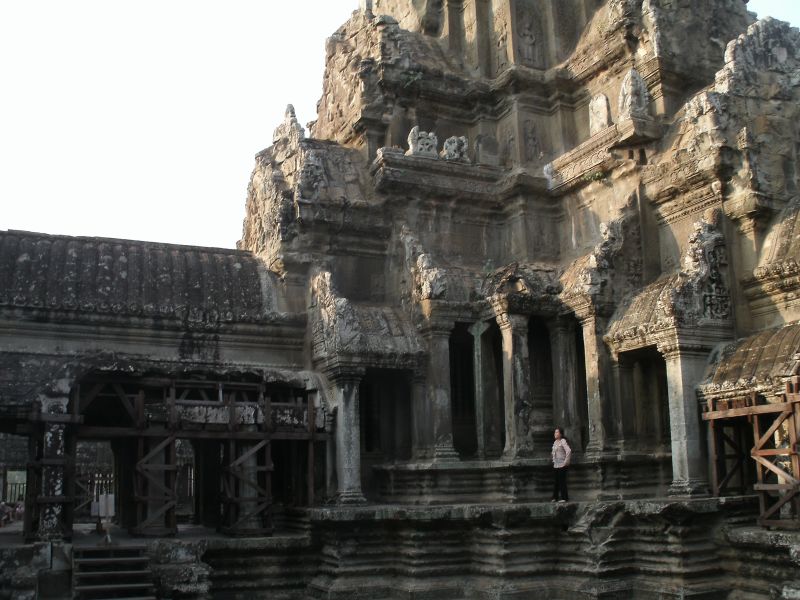
You might not have realized how big the lotus flowers are. Consult this picture while viewing the previous one.

Cambodia has some of the most amazing-looking trees I’ve ever seen. They look like something that exists in fairy tales. This gate between Angkor Wat and Angkor Thom had some good ones growing nearby.

Here’s the thoroughly disassembled temple of Bayon.
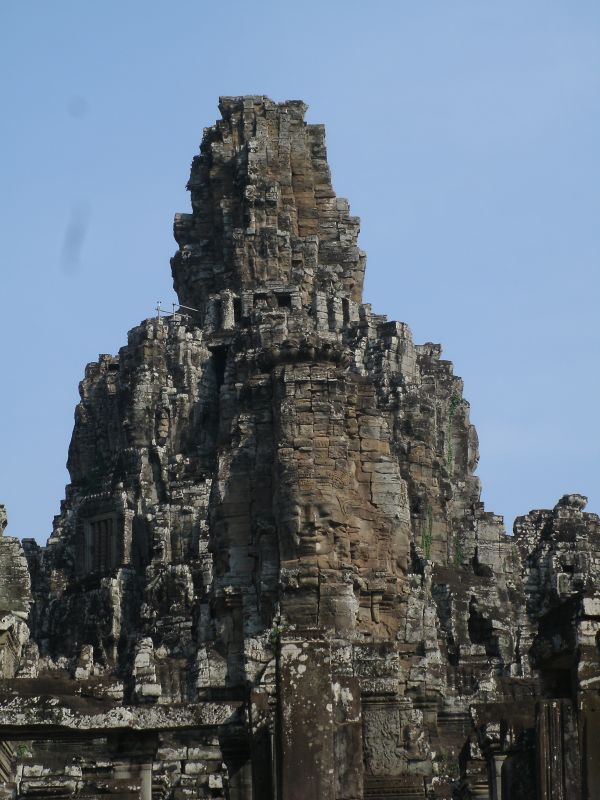
It has faces everywhere.

Everywhere.
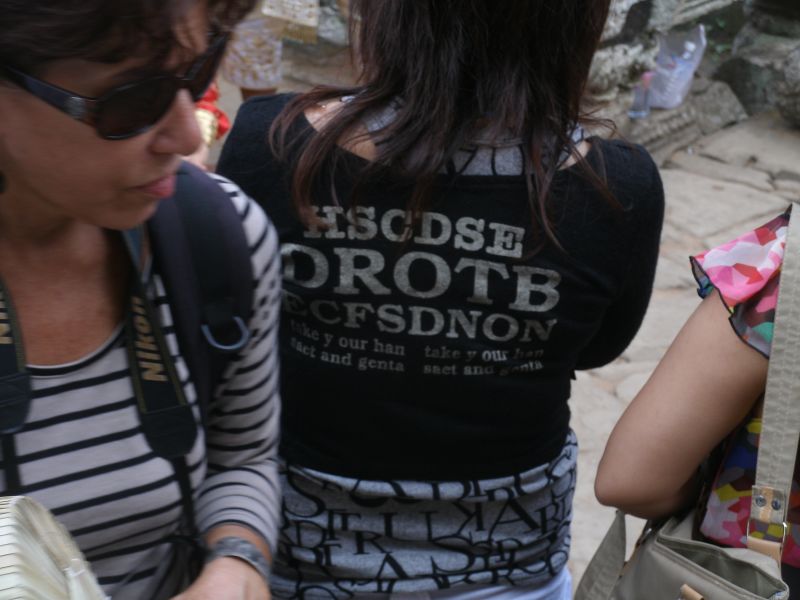
While I was at Bayon, I found someone wearing the most aggressively nonsensical “English” shirt I’ve ever seen.
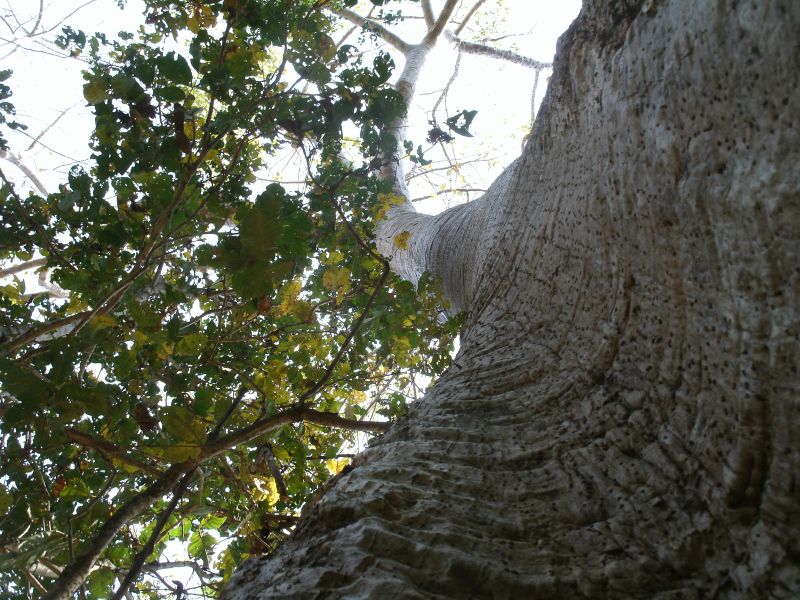
Another excellent tree.
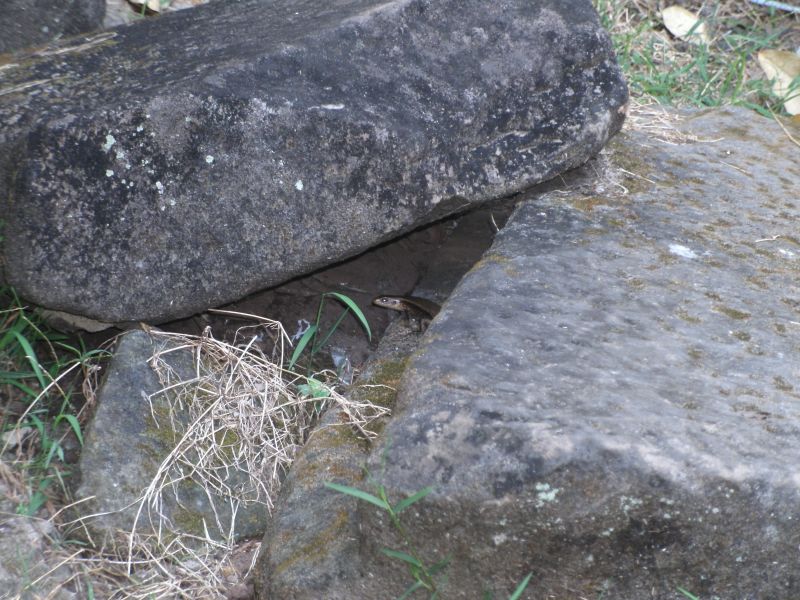
A lizard living in the ruins of Preah Khan.
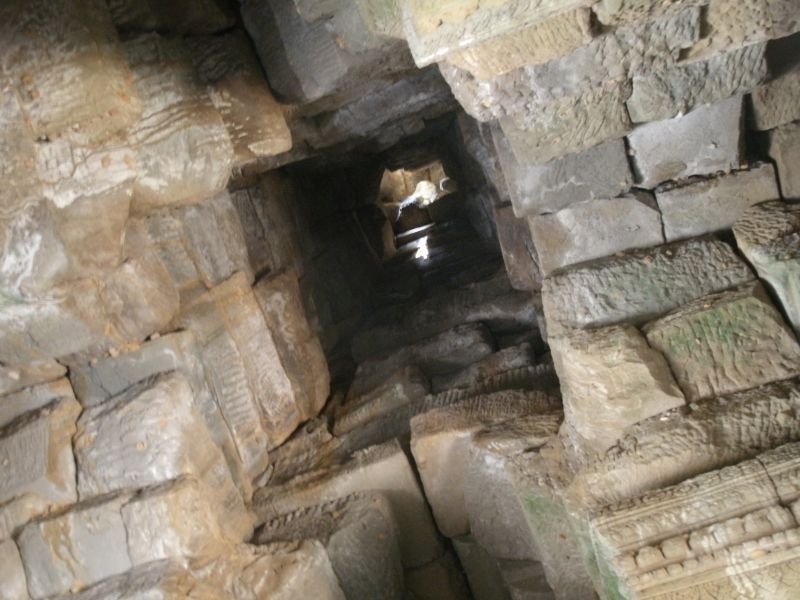
It looks like it should be collapsing on you at any moment.
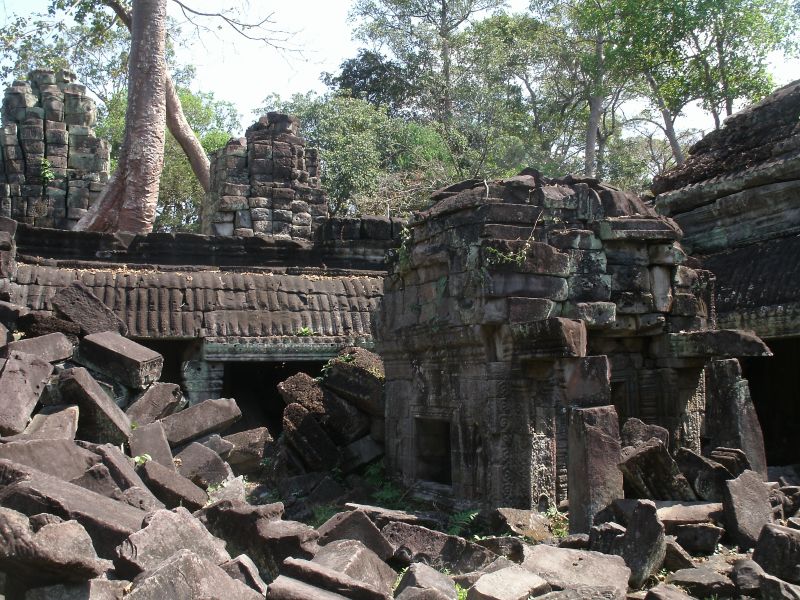
And in plenty of places, it actually has.
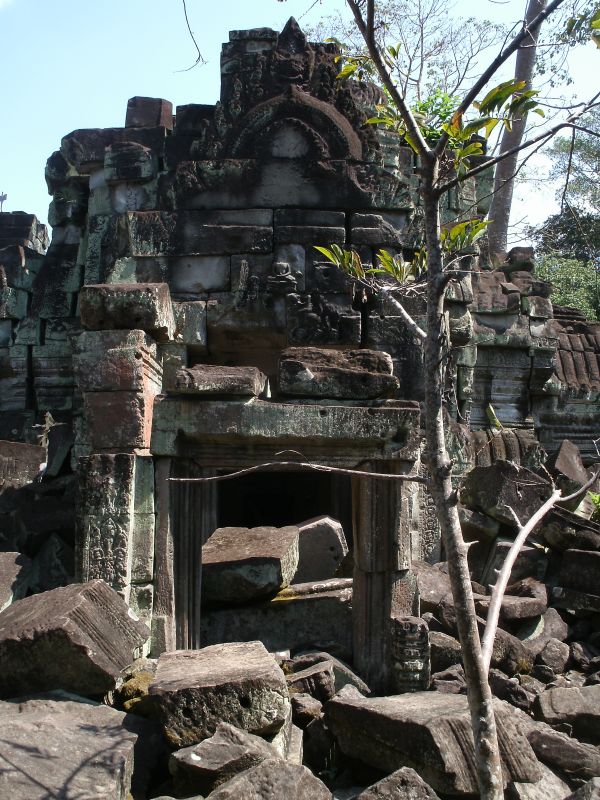
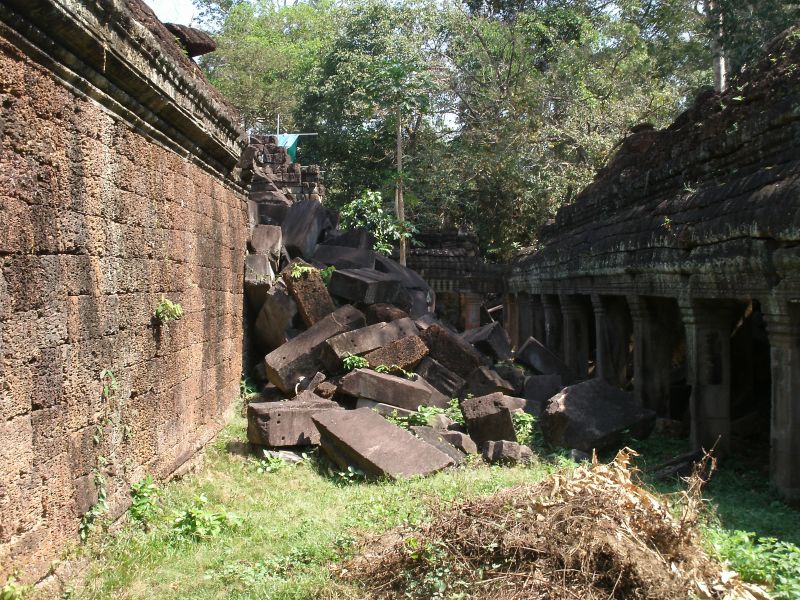
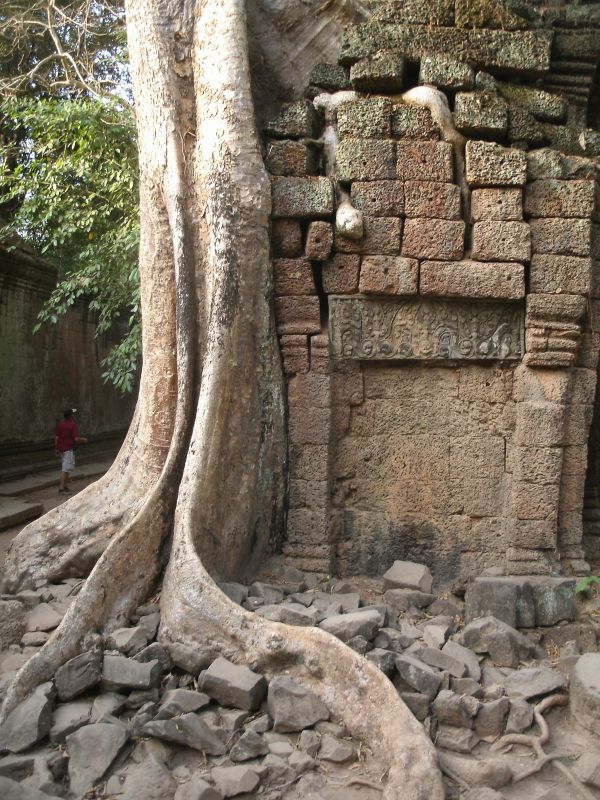
Now trees grow through the old walls and rubble.
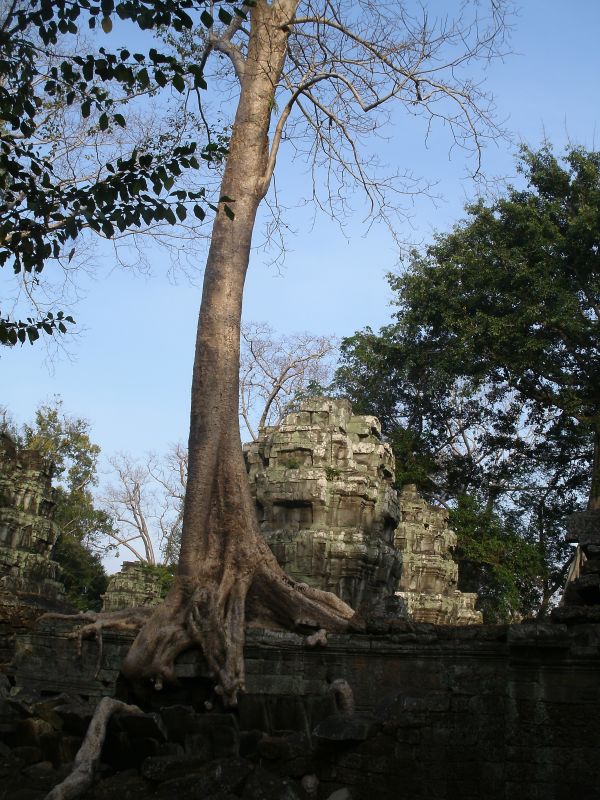
Trees that can only exist because of the incredible vigor of the tropics.
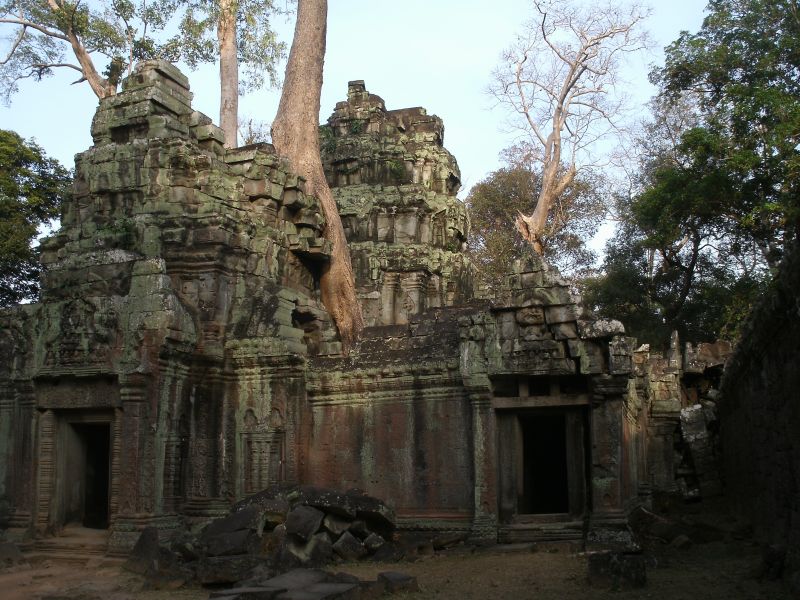
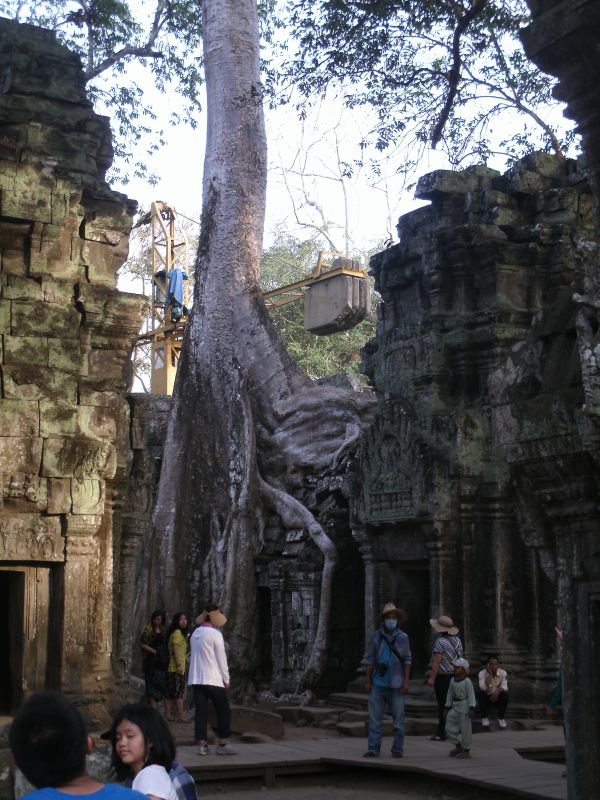
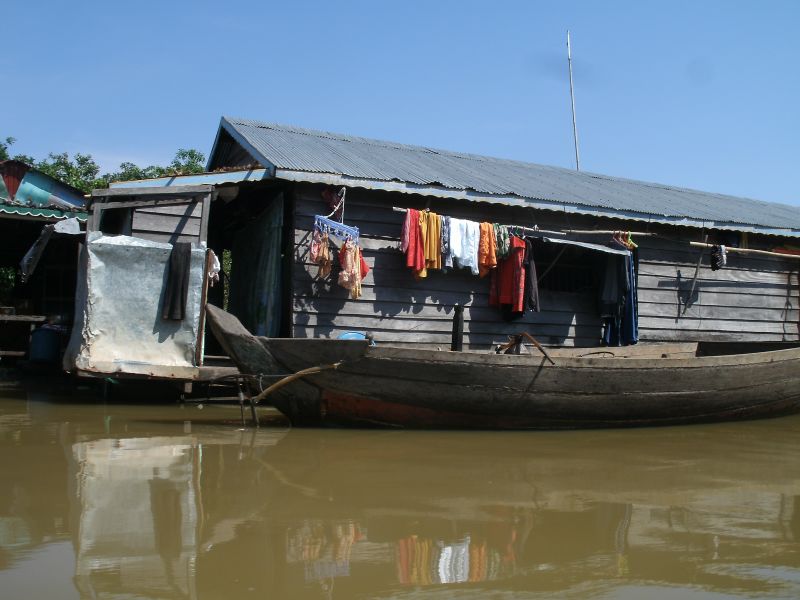
And now, getting away from temples, here are pictures from my trip to the Tonlé Sap. This is what it looks like to live in a floating village. The term is pretty literal.
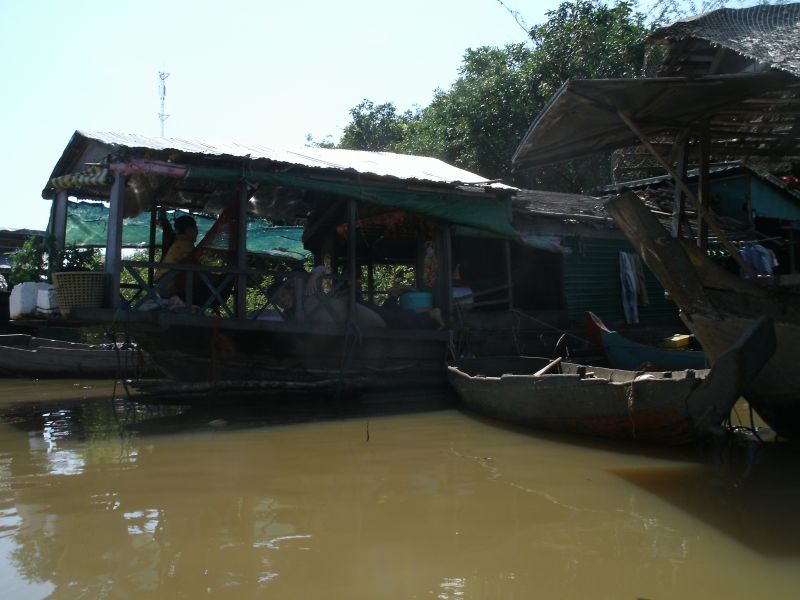
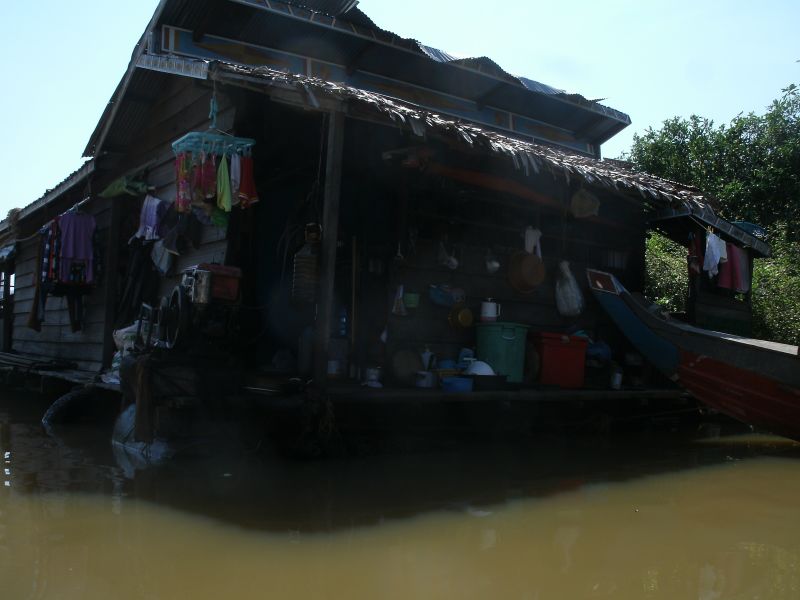
I think this may be a general store of some sort. Or maybe the people who live here are just packrats.
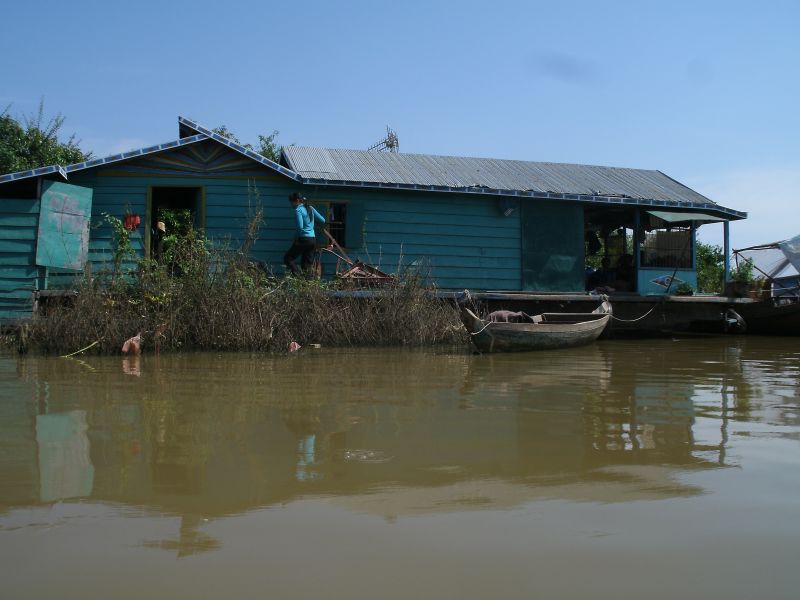
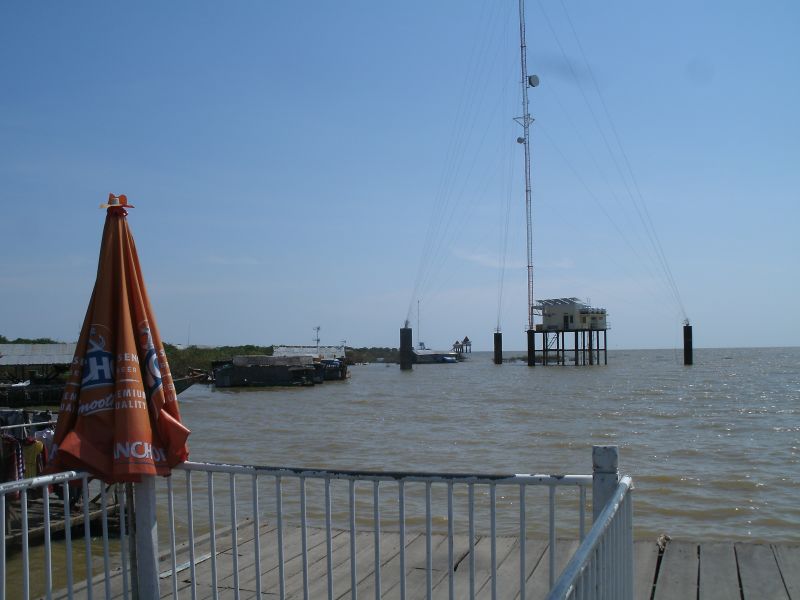
Here’s the view from the deck of the restaurant that Graeme and I got to on the local teenagers’ boat.
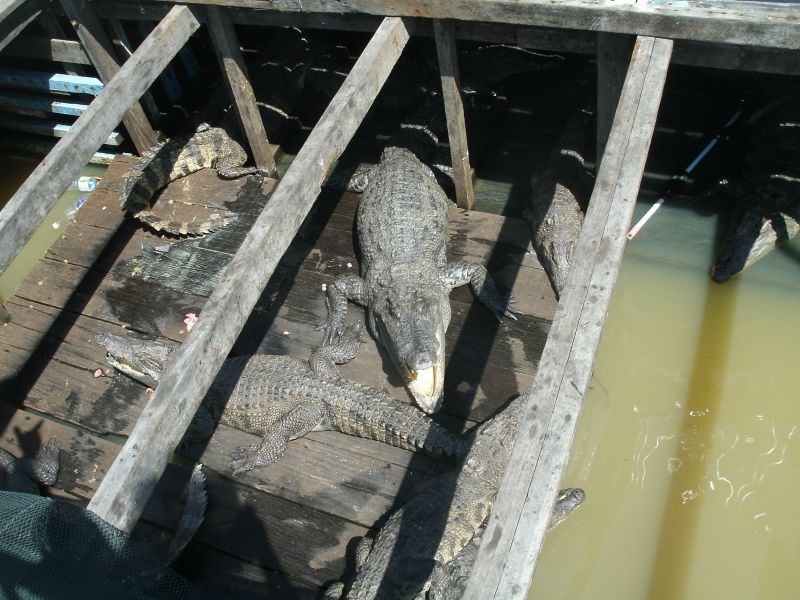
These are the alligators in the tank there that Graeme was unafraid to swim with. Though he wasn’t swimming in this tank, but rather in the Tonlé Sap itself.
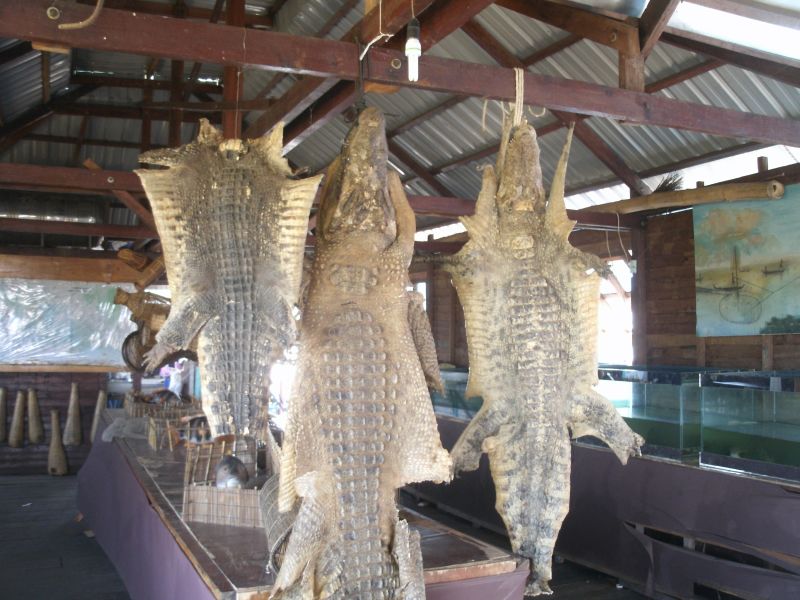
And here are the alligator skins they had hanging there.
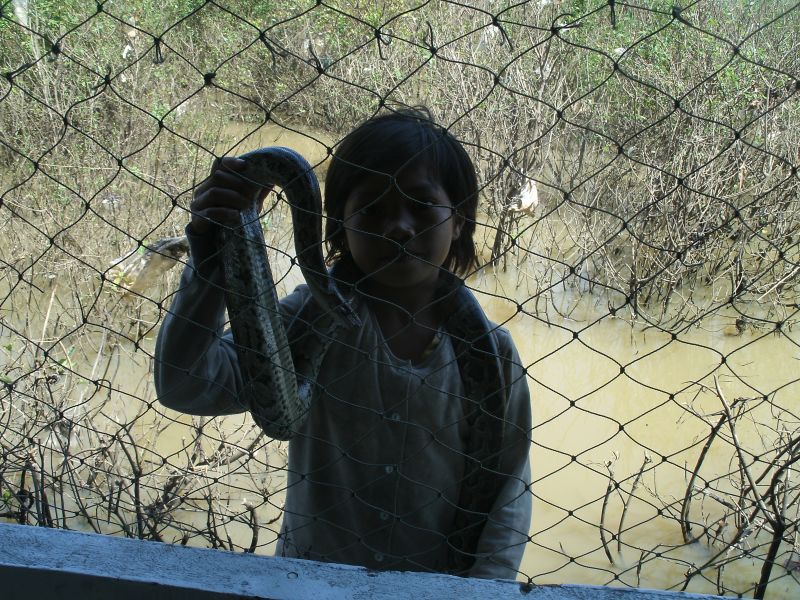
One of the kids who went around letting people hold his snake, then asking for a dollar.

Before we leave Siem Reap, here’s the view from my hostel’s roof restaurant.
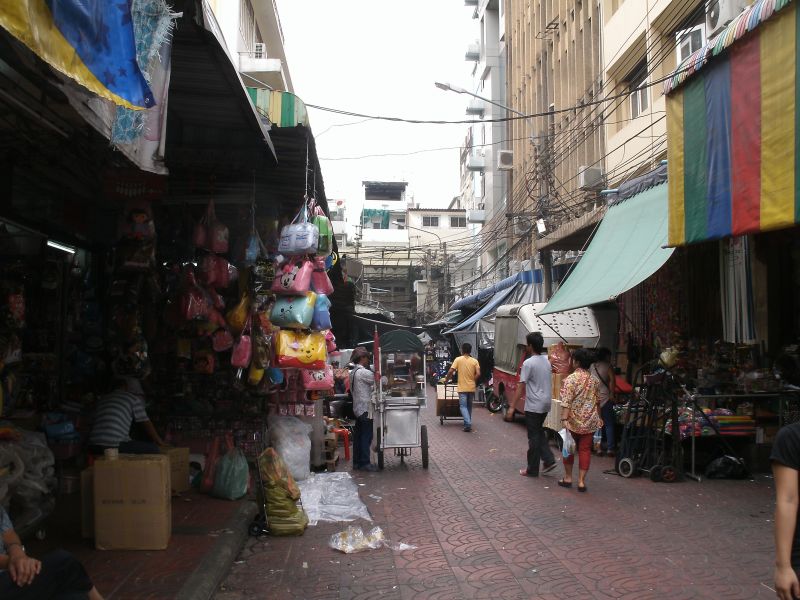
Lastly, back in Bangkok. Here’s the Chinese market. Or rather, a tiny portion of it.
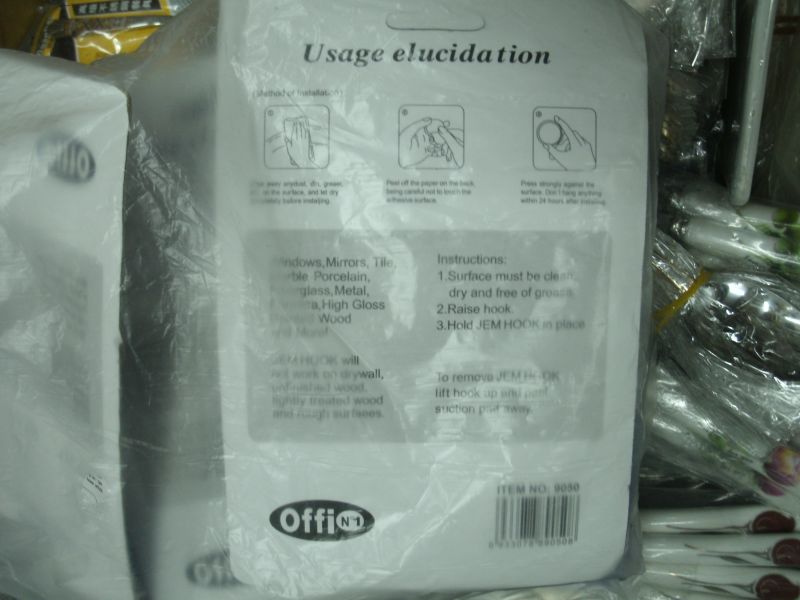
You can get every miscellaneous kind of goods here, including things you can’t even figure out.
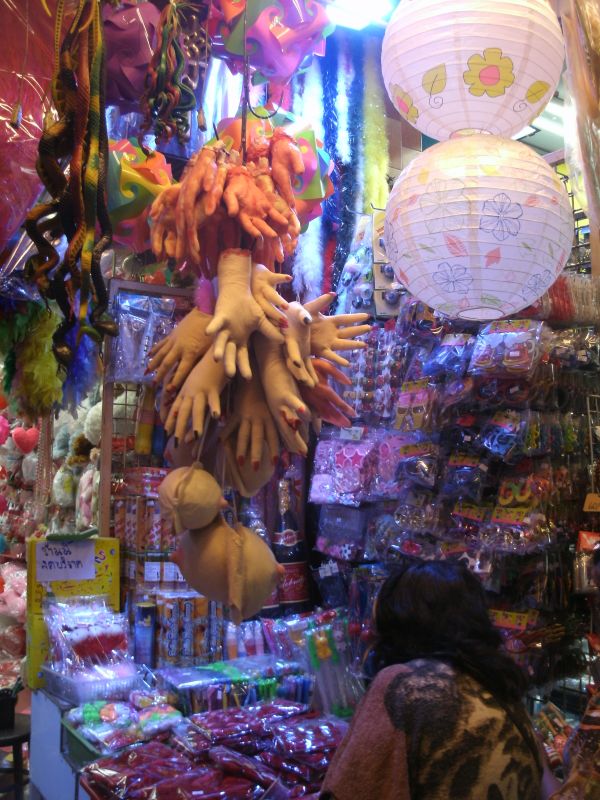
Or, should you prefer, you can get a lantern or a stuffed hand or some useful breasts.
That’s a weird place to end these pictures, but hey, I’m doing it chronologically, and that’s where I finished my trip. The only other things I did after this were walk back to Khao San Road and find a minivan. And, I guess, come back to Korea and continue living my life—but it seems like that hardly counts, since everything was so lively there.
Anyhow, I still haven’t written about any current events, but I’ll get to it next blog (not counting the one about patterns). For now, enjoy these, and if you now look at the Chinese market and wish I’d gotten you some breasts or hands or a Jem Hook, I apologize. I don’t know when I’ll be able to get back to the market again. But I do hope it’s someday.
File under: photos, adventure · Places: Thailand, Laos, Cambodia
Note: comments are temporarily disabled because Google’s spam-blocking software cannot withstand spammers’ resolve.
8 Comments
Anonymous
HistoryAll I can say is WOW. You have captured the essence of the area. I would have liked to see pictures of the place in Laos where the rafting/whiskey was, though. I still can't imagine that place. Anyway, seeing these things through your eyes has made me want to see them on my own trip there–now if I can just get Grandpa on the same page. Ha. BTW, we are going to be in Spain/Portugal in October. If you are going to be bumming around in Europe then, we could get together. We'd be able to spend some time in Madrid, for sure. Grandma
Anonymous
HistoryTaunting and haunting images. Grandma is right, I need to get on the same page. I have wanted especially to see the temples of Angkor Wat. And the trees, which remind me of some in Costa Rica. Maybe it is a tropics thing. I will need to look at these pictures at least one more time before I can really comment on them. In the words of Grandma— WOW!. G.Pa.
Anonymous
HistoryBlogger won't let me leave my comment, which is "stunning". Mom
Chuck
HistorySo I guess you guys like them?
Sorry I don't have any pictures of Vang Vieng. This seems to be a decent collection of photos to give you an idea of what it looks like around there.
Meeting up in Spain/Portugal sounds terrific. What days would you be able to do it? I'll be arriving in Eastern Europe via Poland in late September, then probably messing around in Germany for a few weeks. I was planning to go to England after Germany, but I still haven't worked out when exactly.
Anonymous
HistoryWe'll be arriving in Madrid on Oct. 10 after flying overnight. We fly home from Lisbon on Oct. 23. I can give you more details later if you can work things out. We will be with a tour group, but there is still free time. Grandma
Chuck
HistoryWill just anywhere in that window work?
Anonymous
HistoryHere's the schedule. Days 2 - 4 Madrid. Days 5 - 6 Cordoba Days 7 - 9 Torremolinas Days 10 - 11 Seville Days 12 - 14 Lisbon. You could visit us anytime during that time, but we'd have more free time at the beginning in Madrid. If you can get to any of those places, we'll be happy. Trains in Europe are easy. You can manage it with no problem from Germany, or go back that way when you're done with Spain. We'll be so excited to have time with you however it can be worked out. Grandma
Anonymous
HistoryGrandpa wants me to explain to you that we leave the US on October 9. That would be day one of our trip. So you can figure out what day we will be in each place. Hope that is not too confusing. Grandma